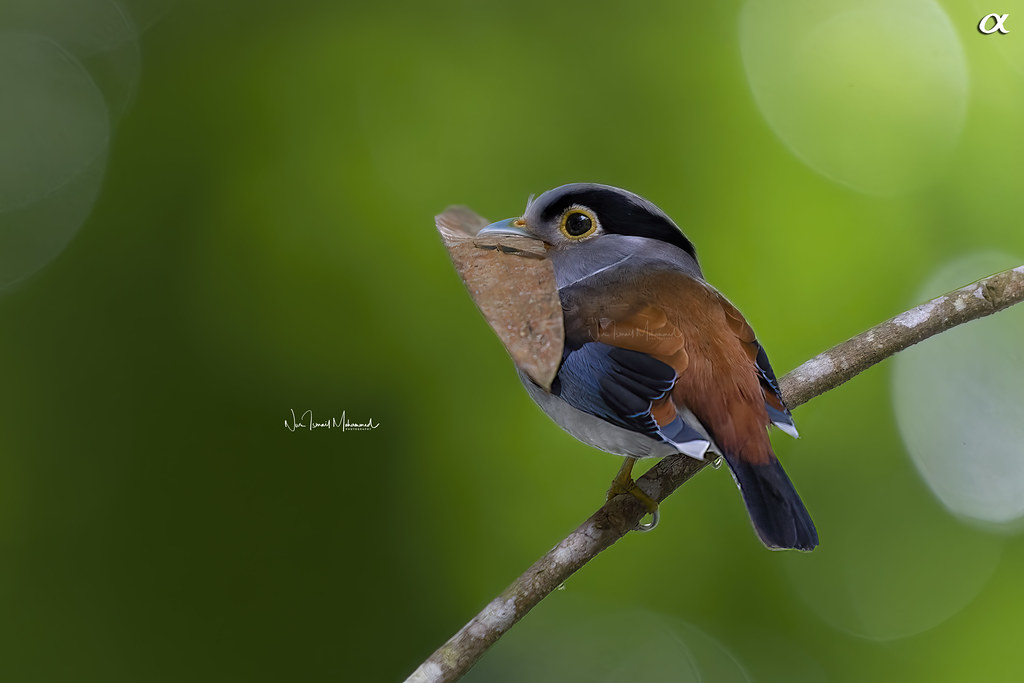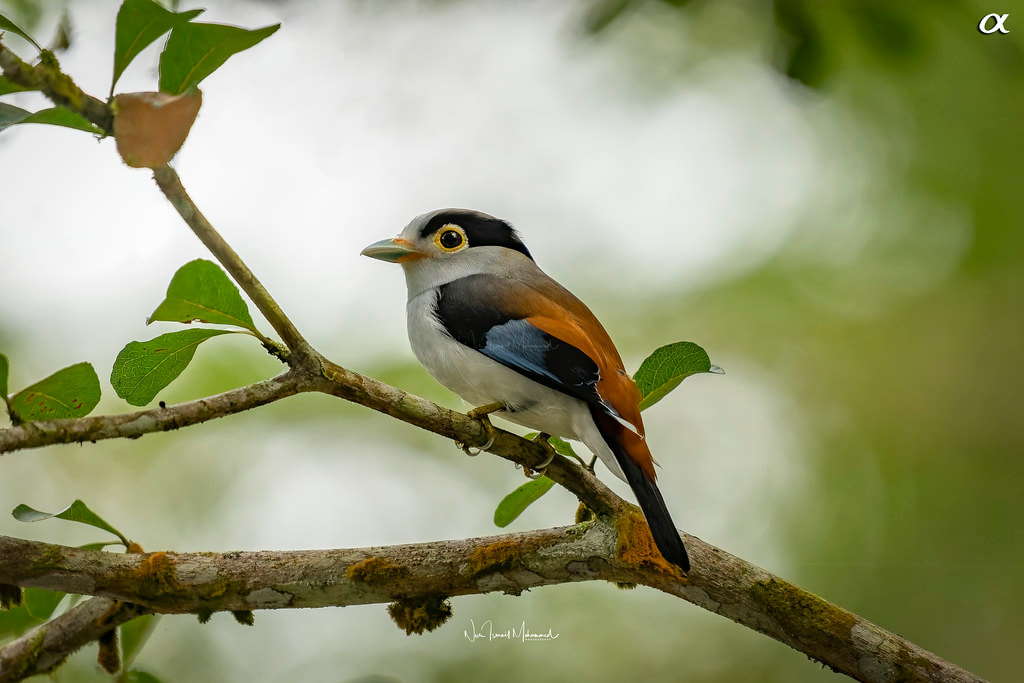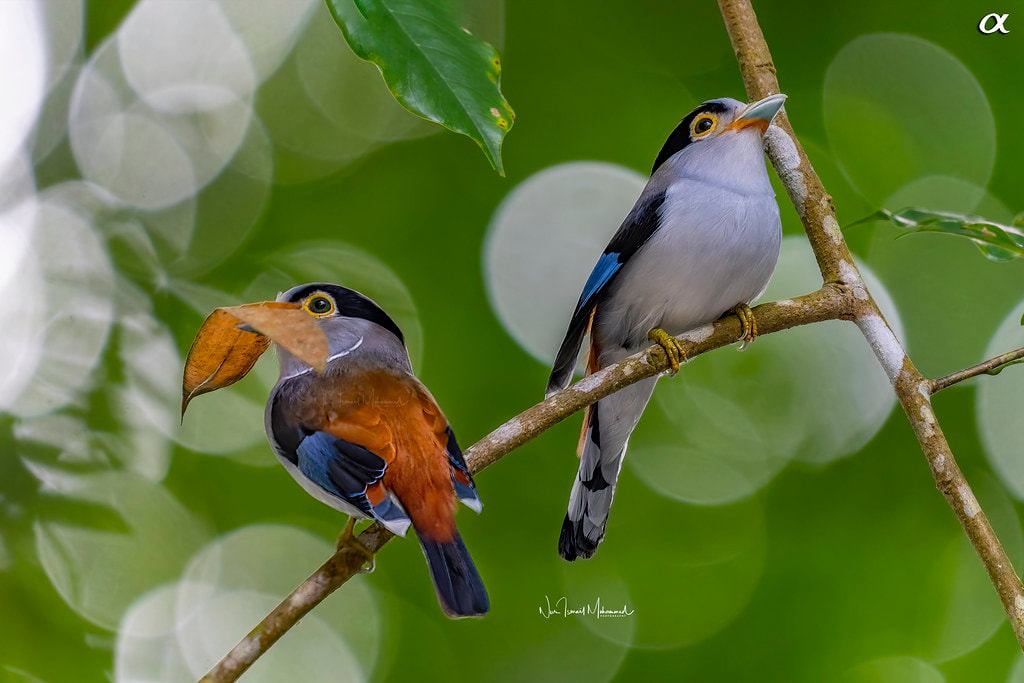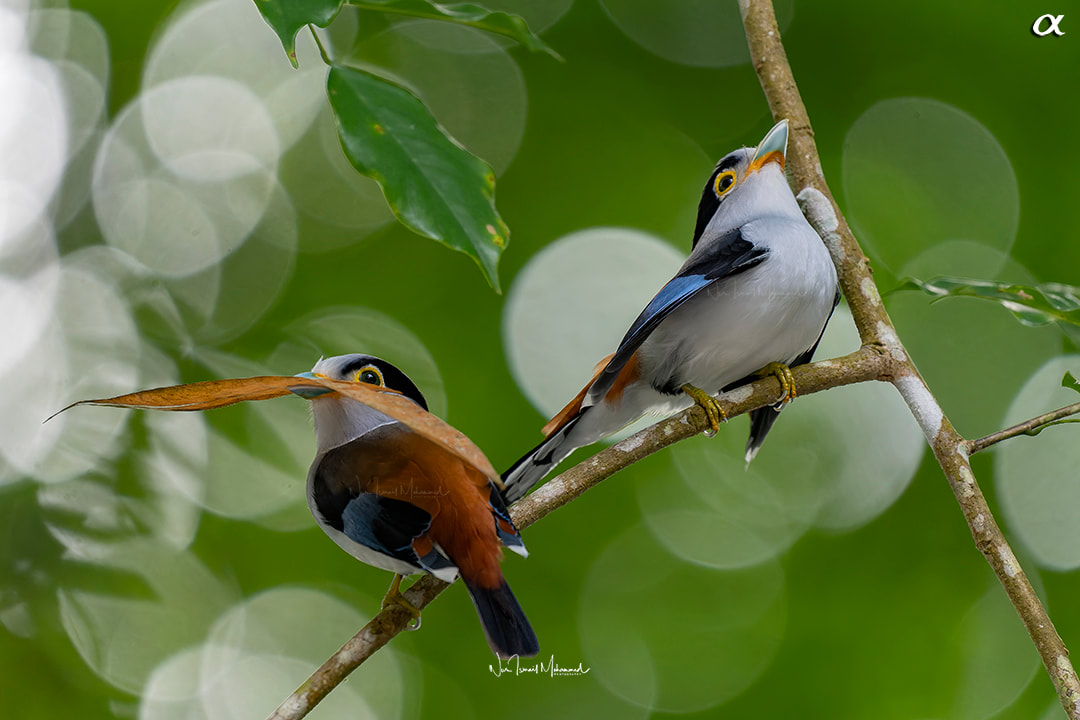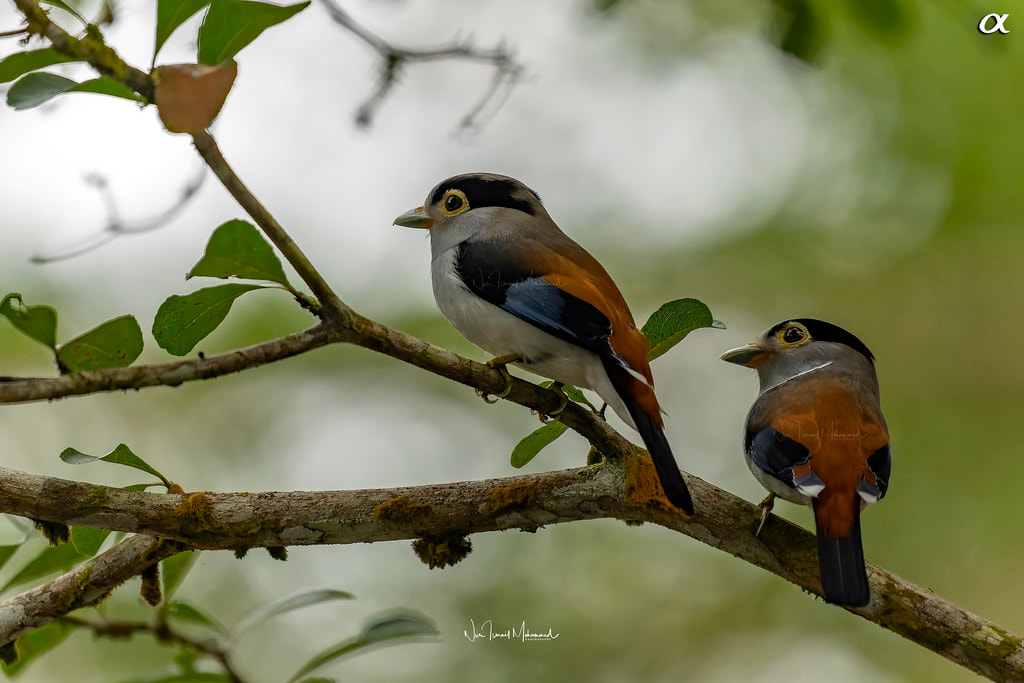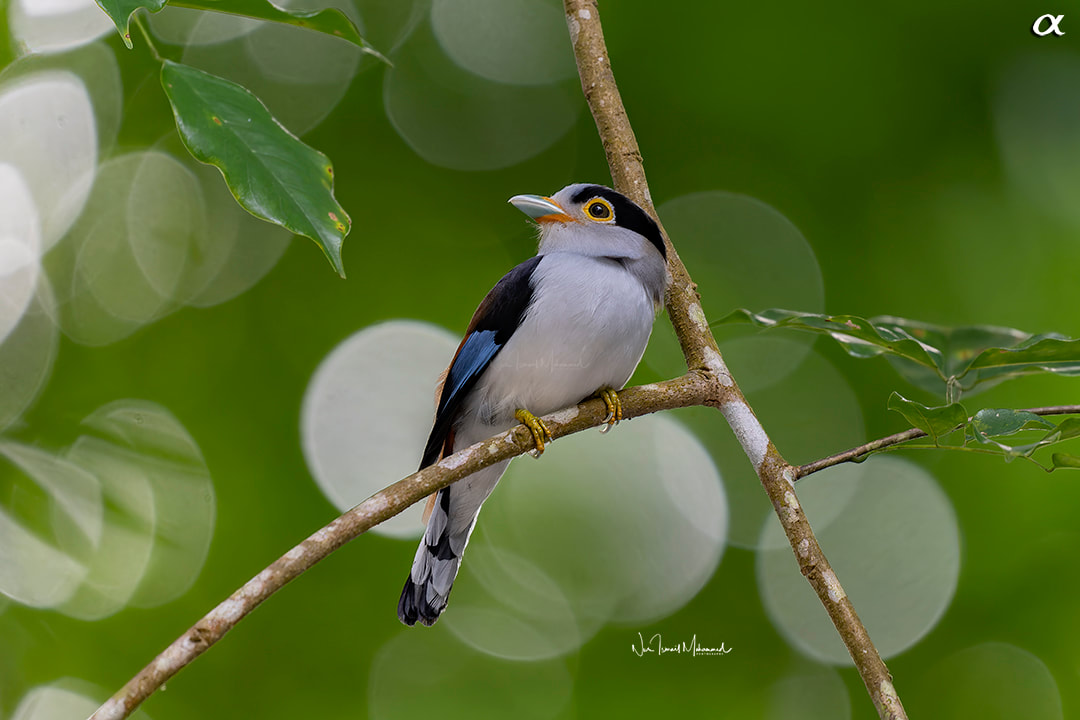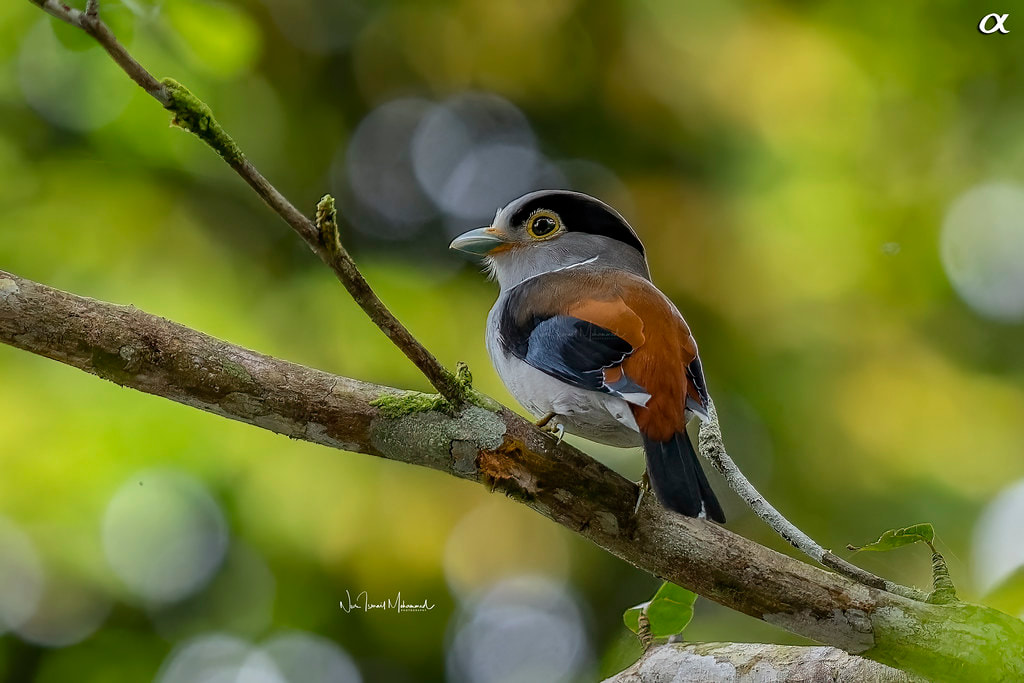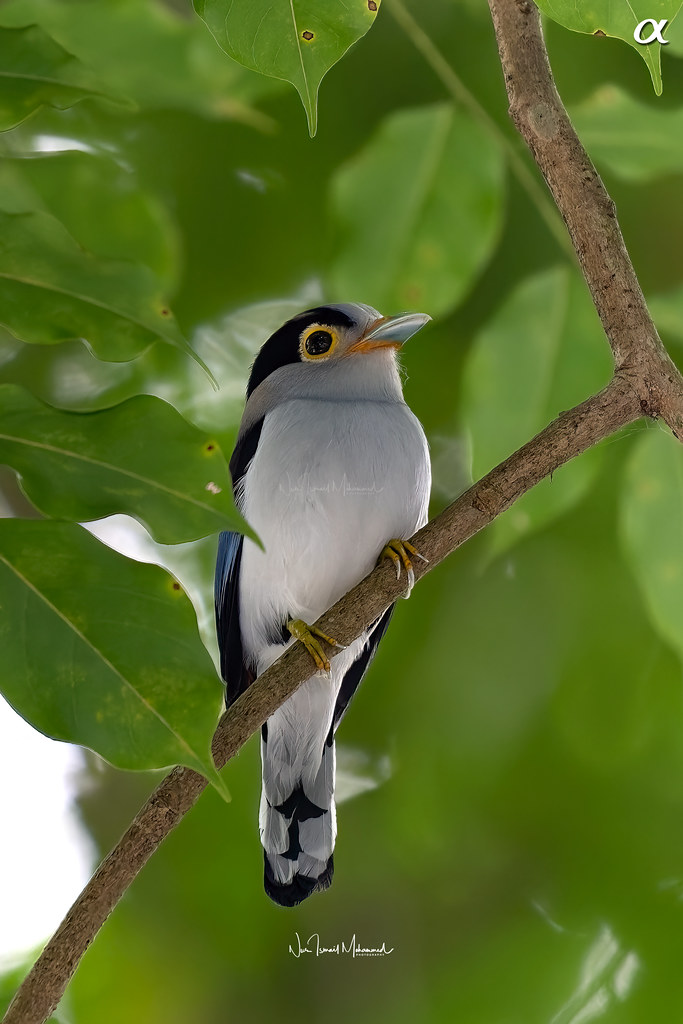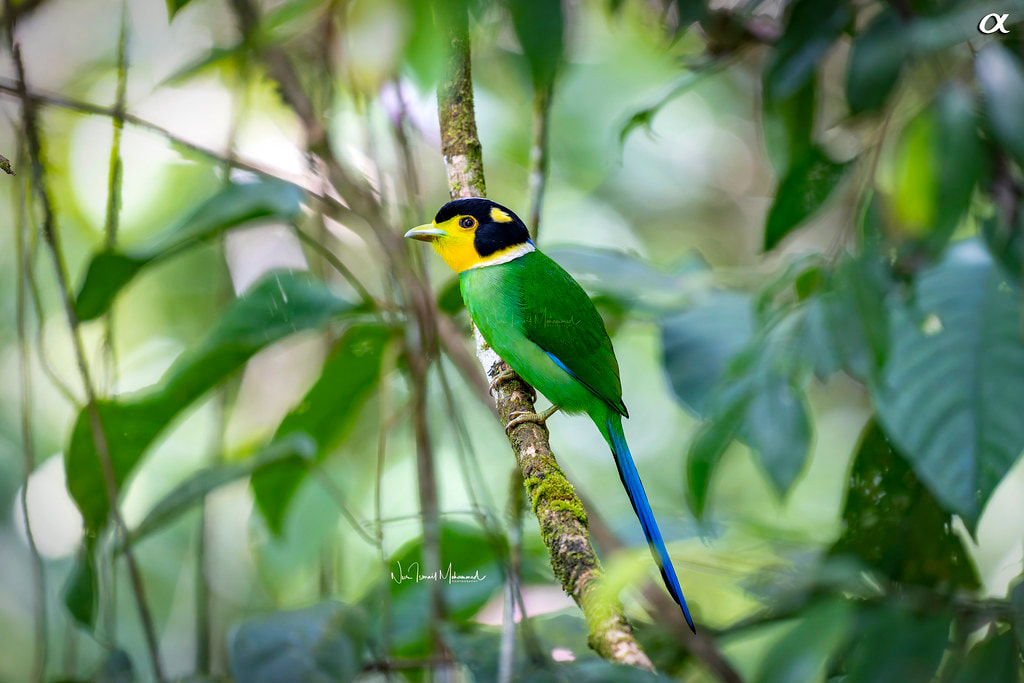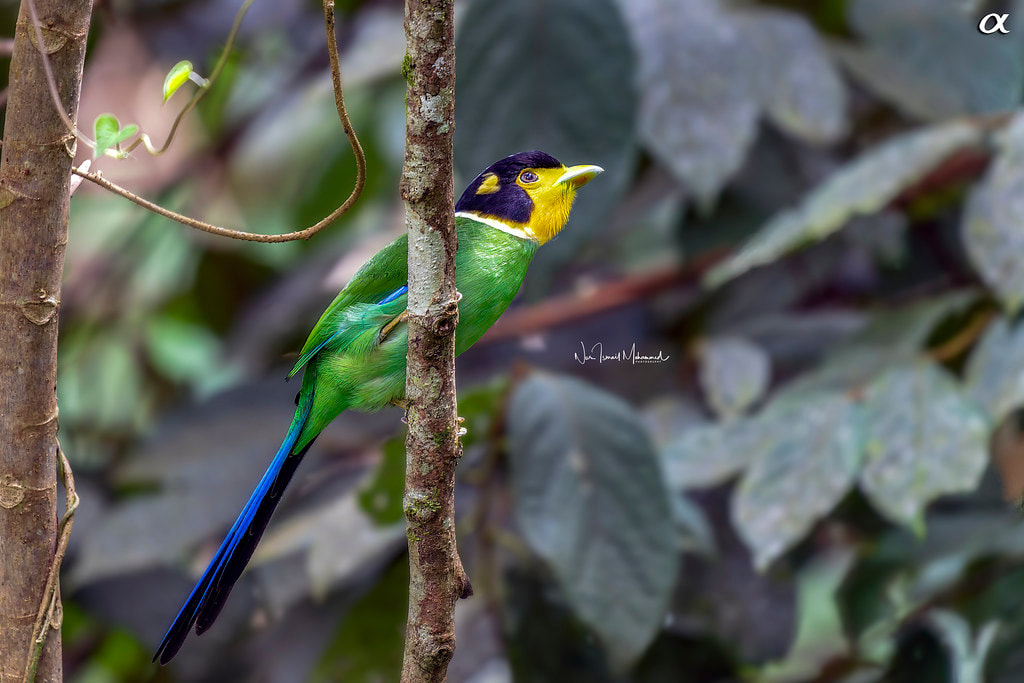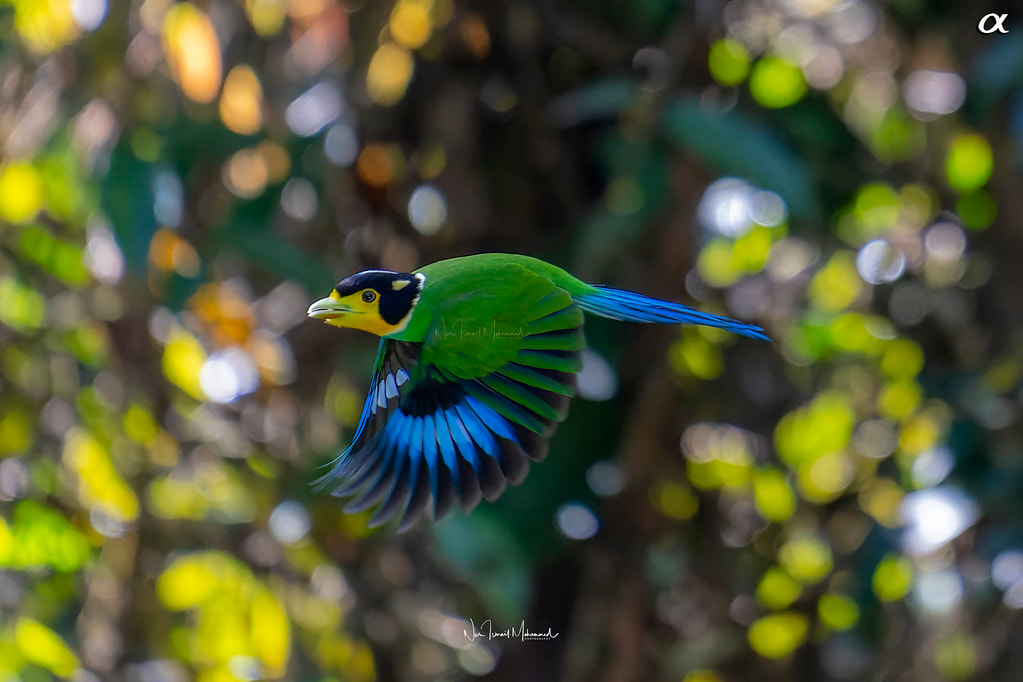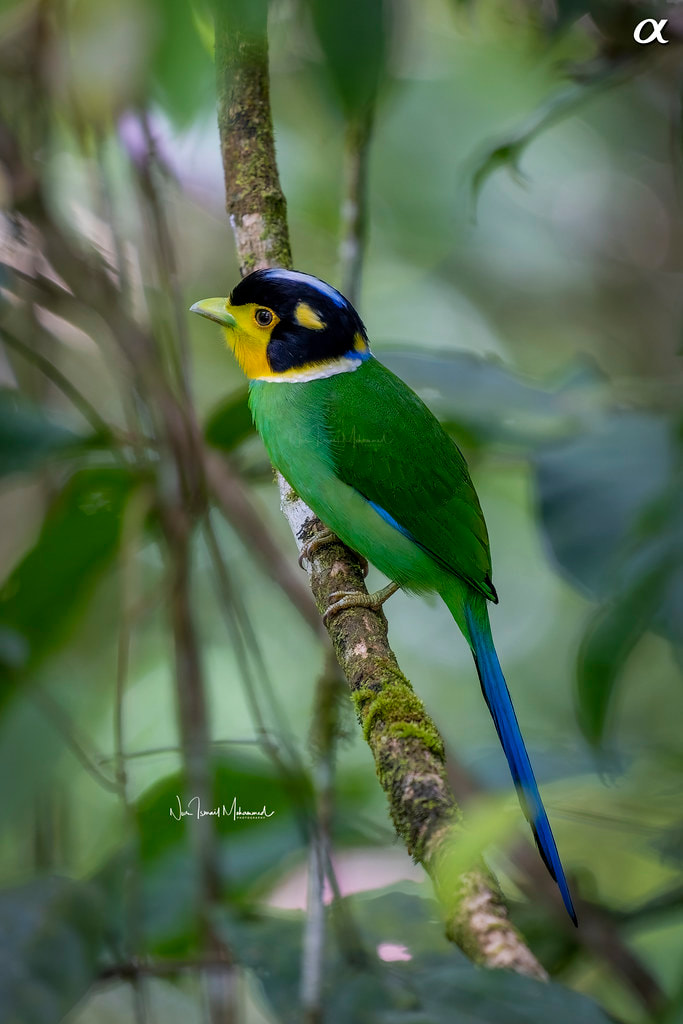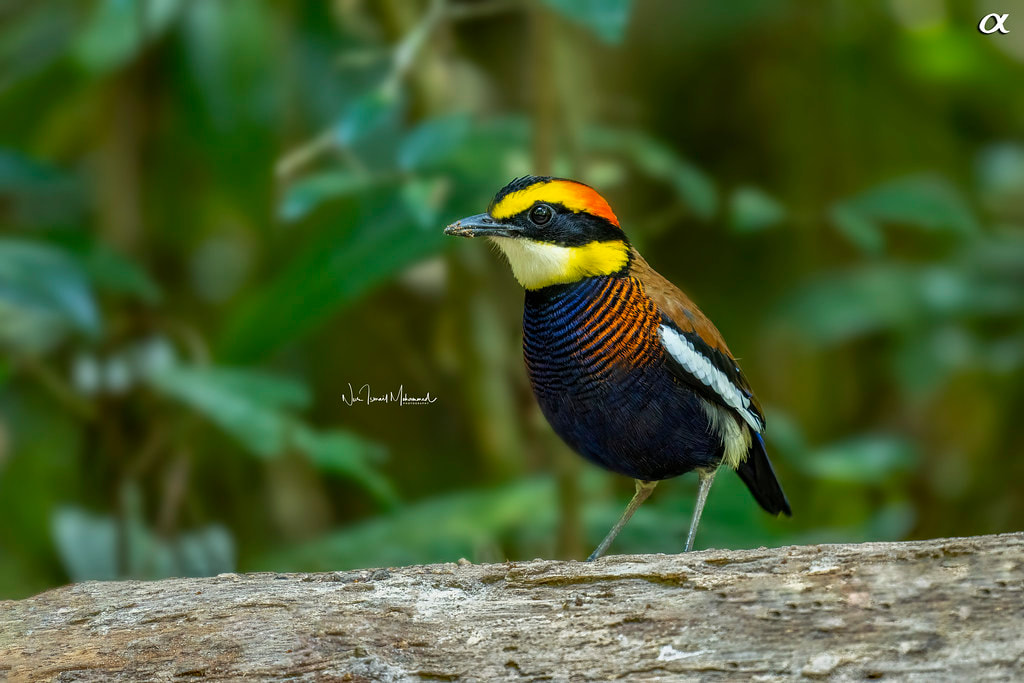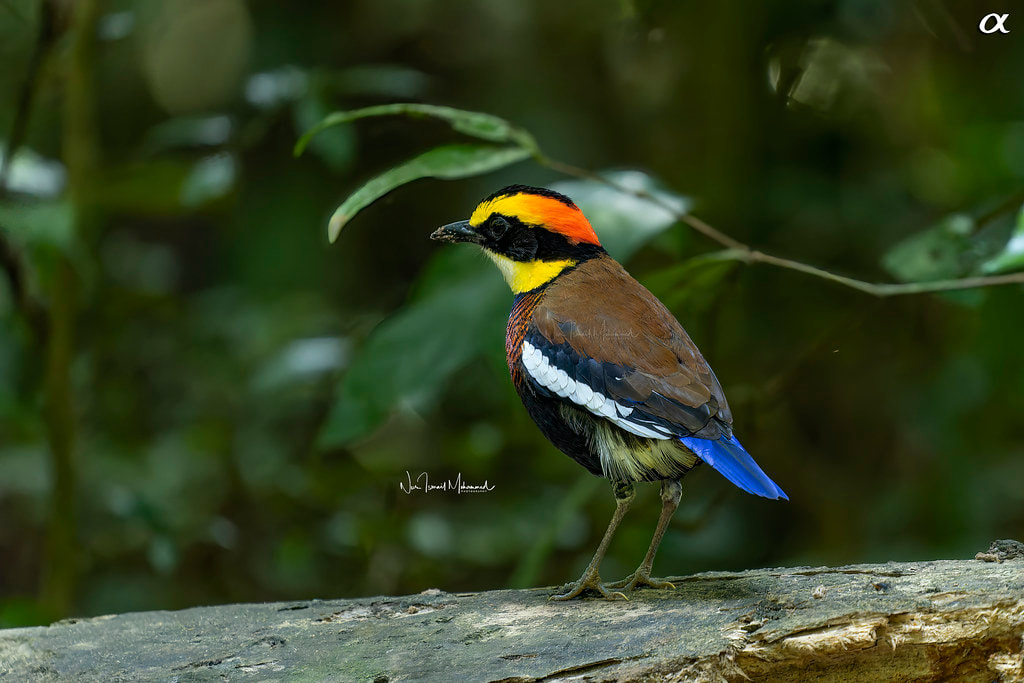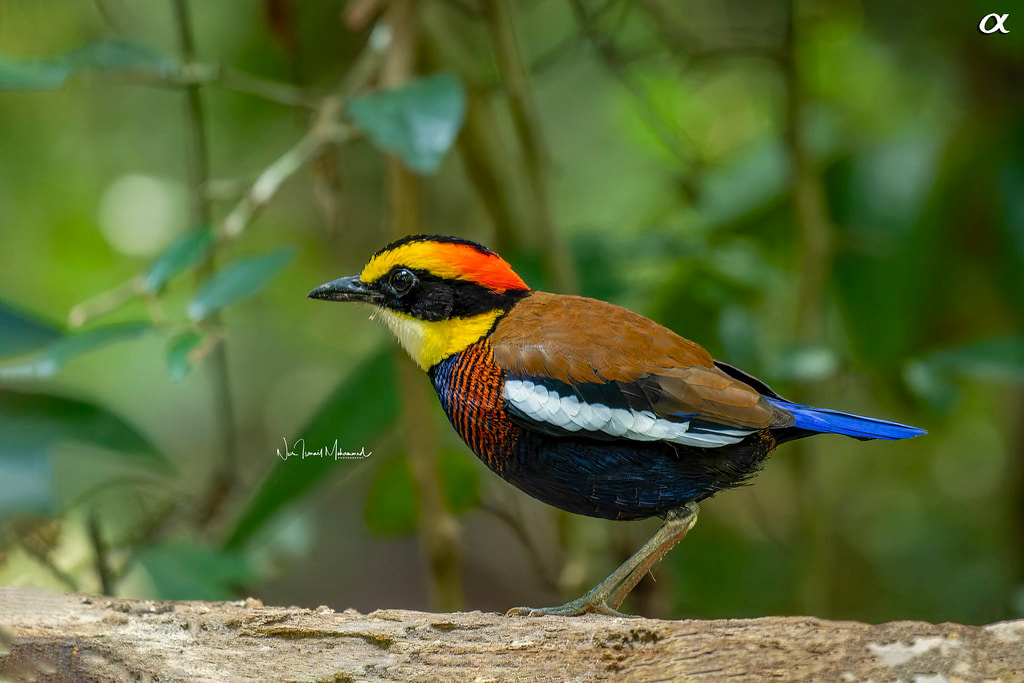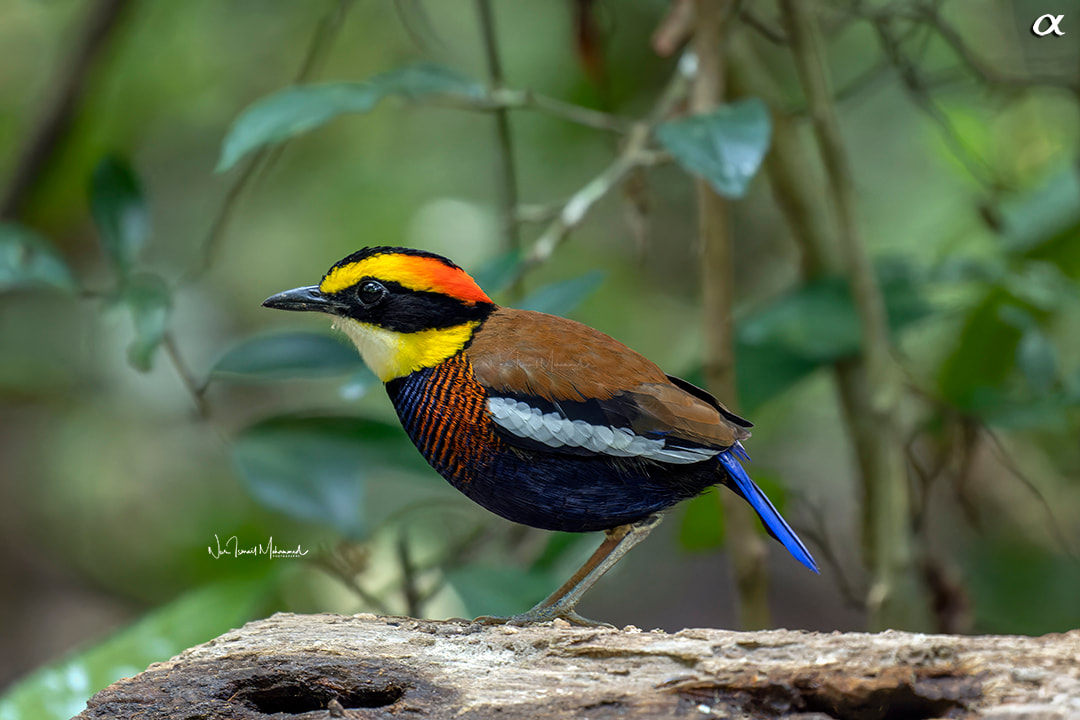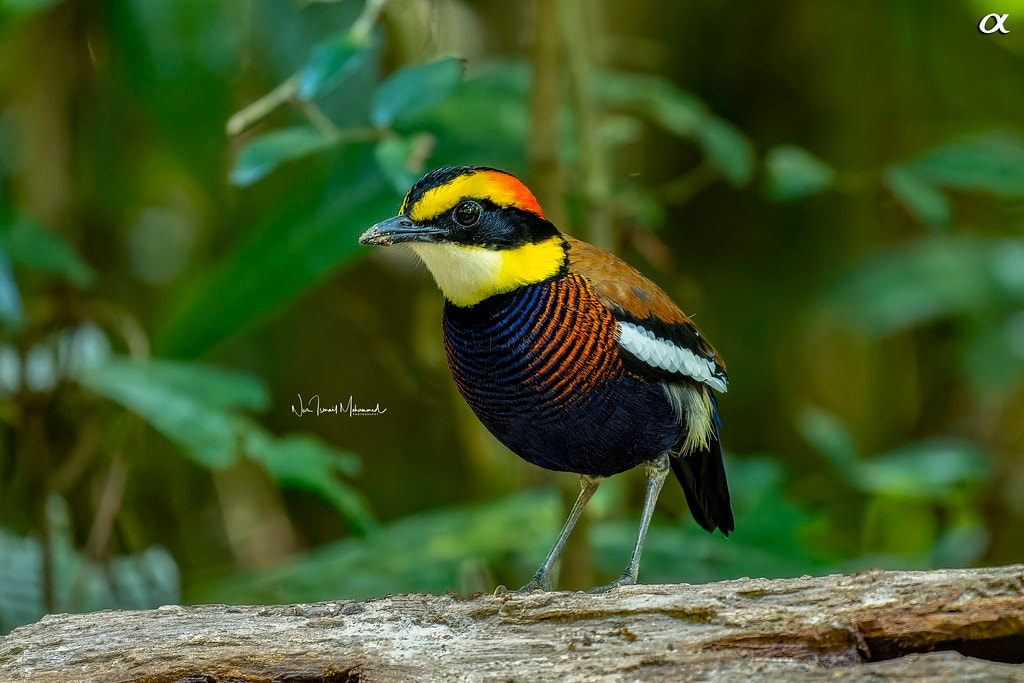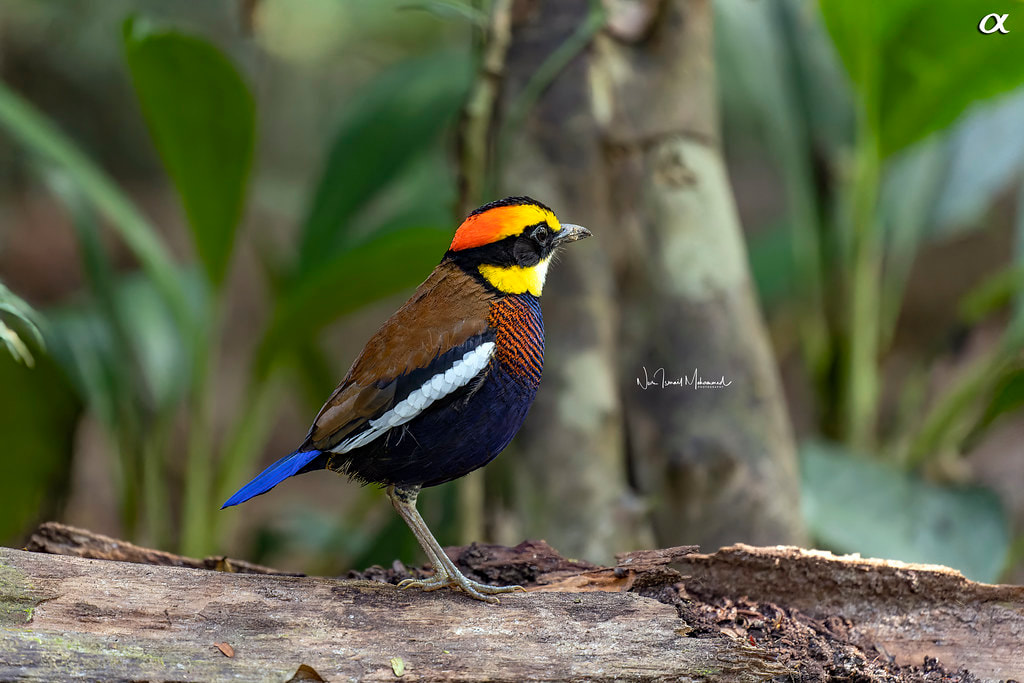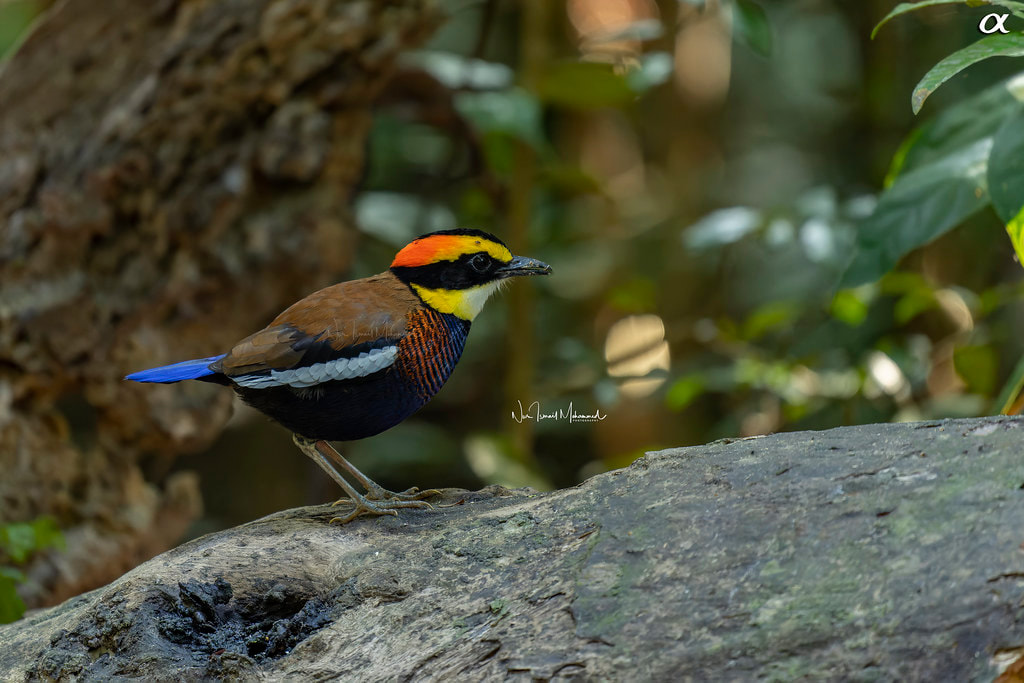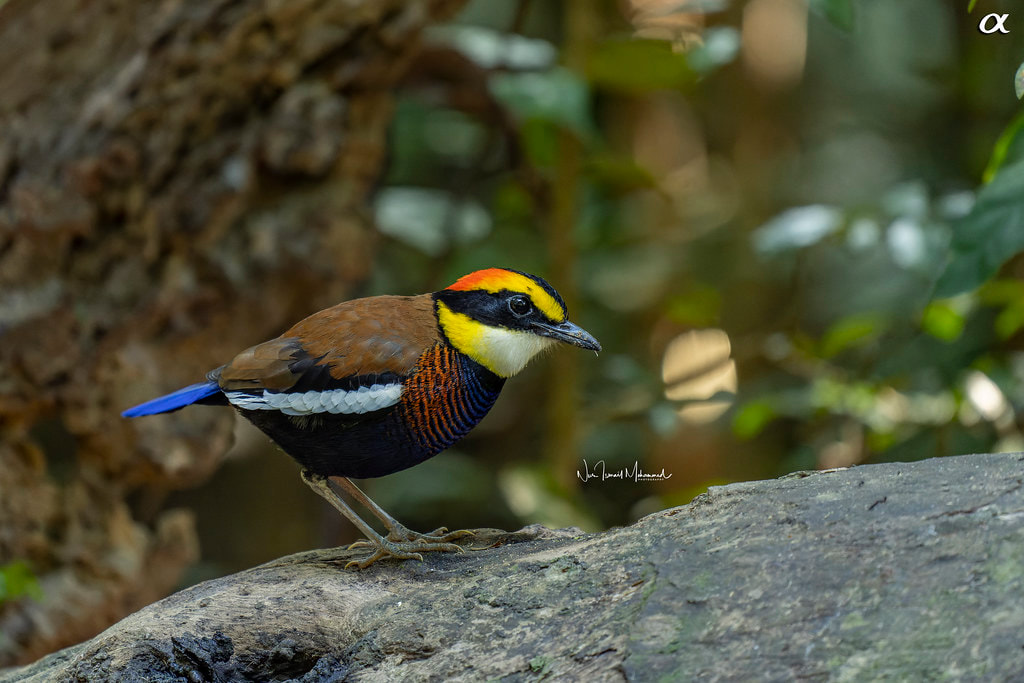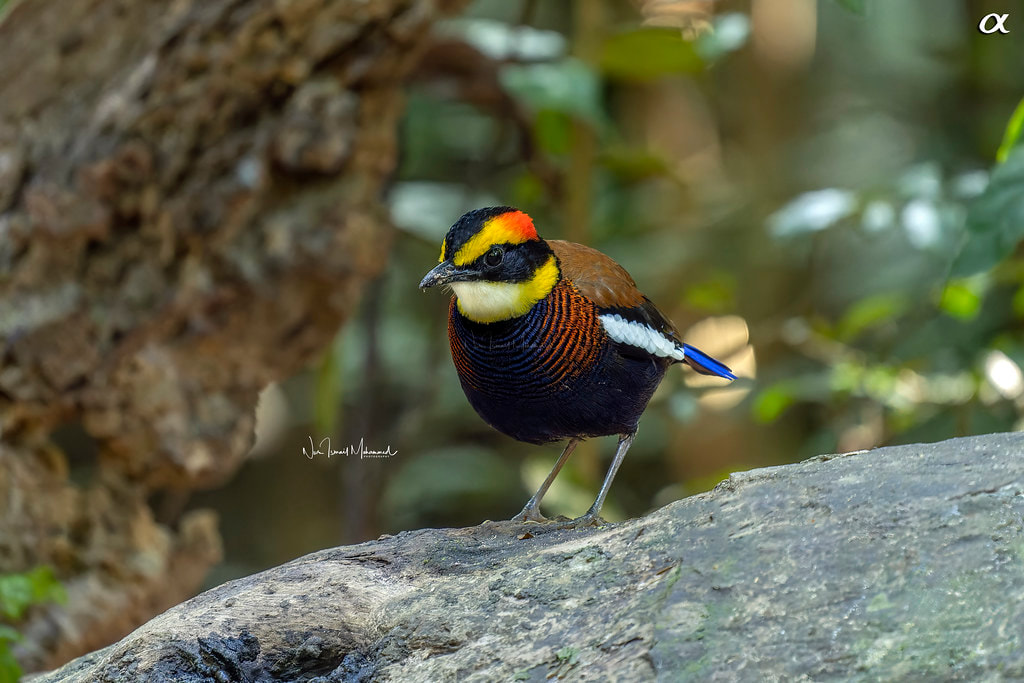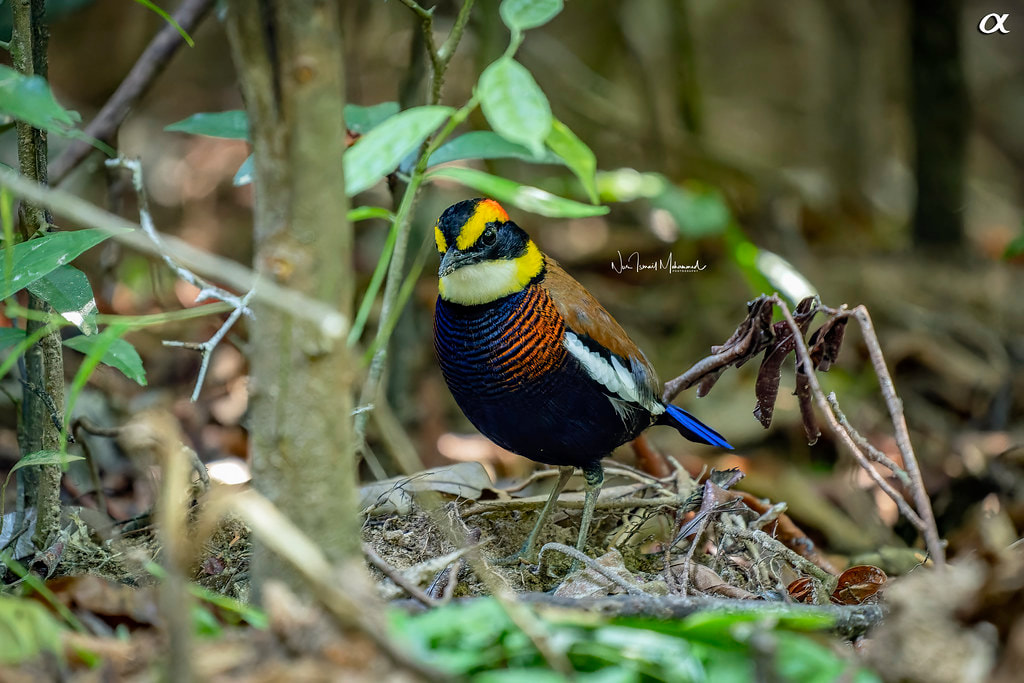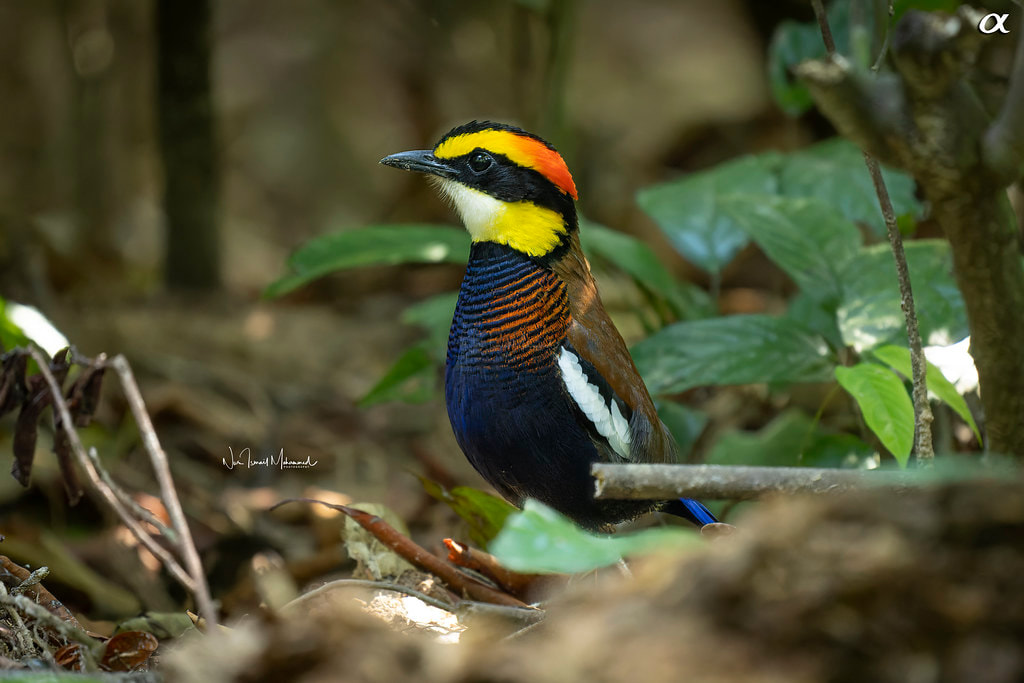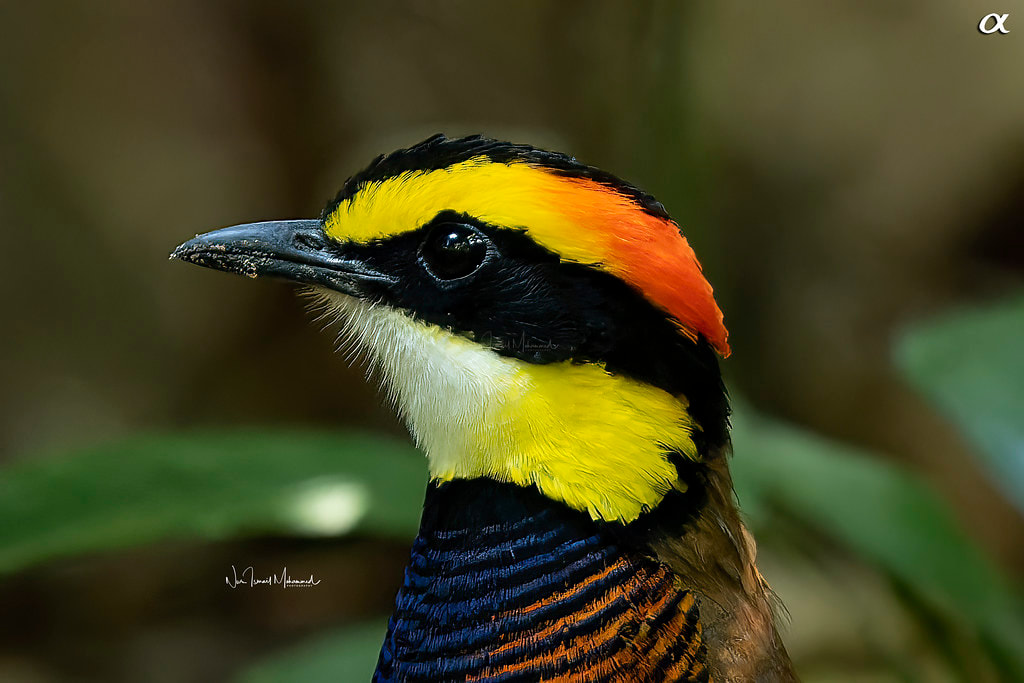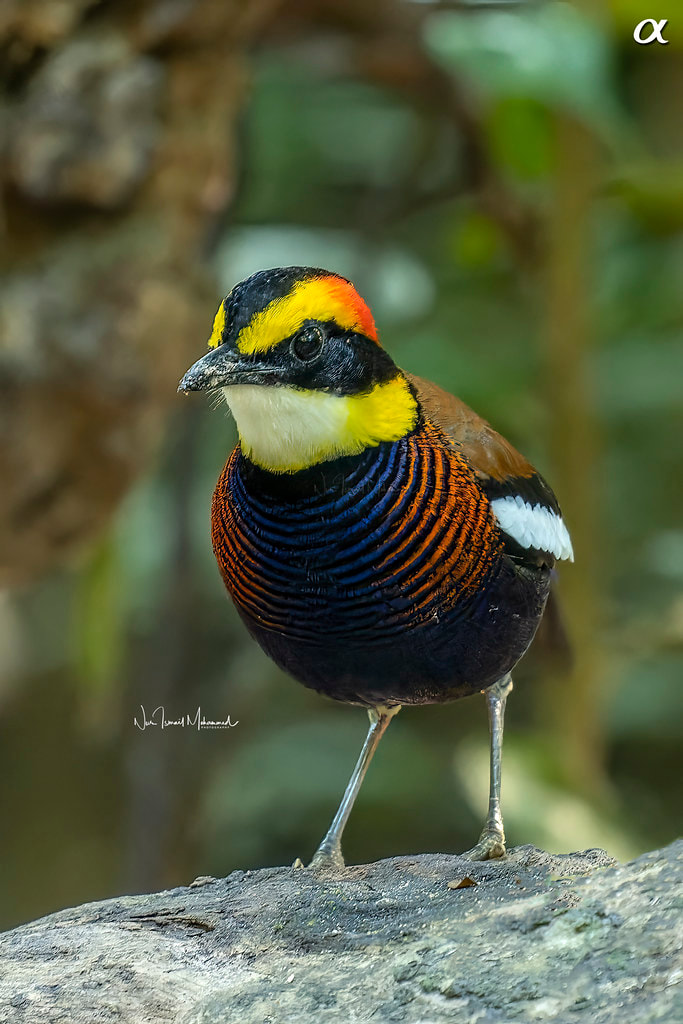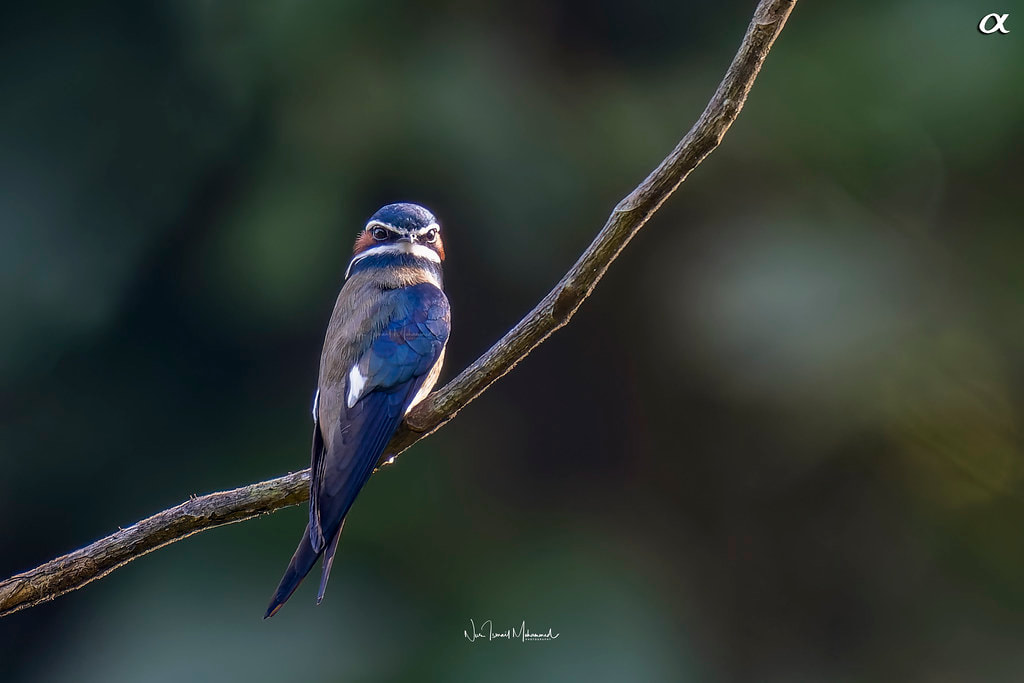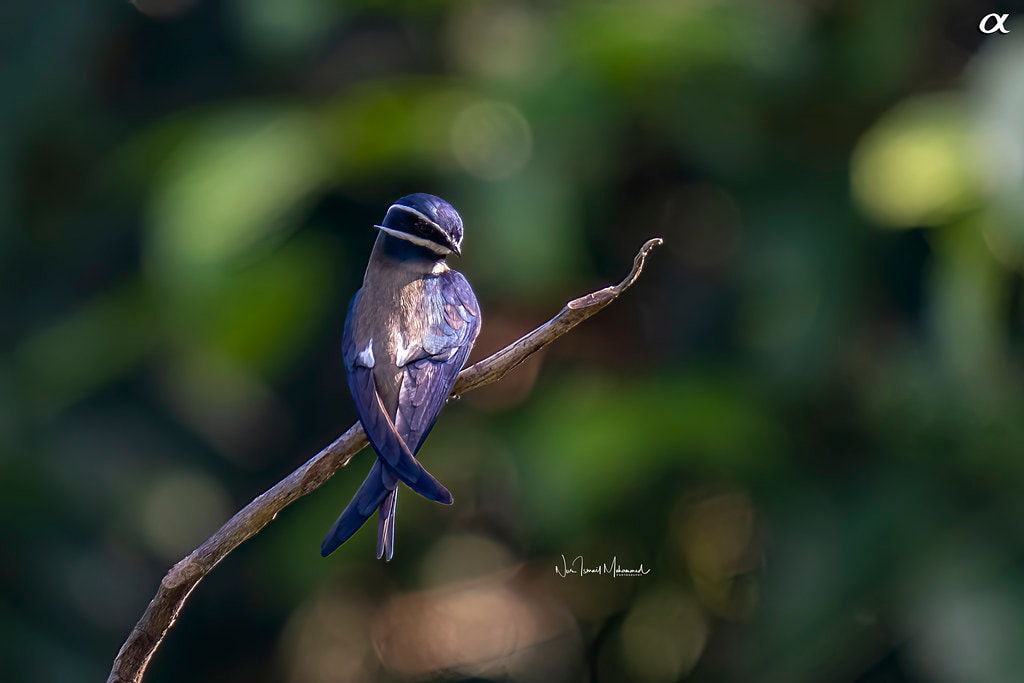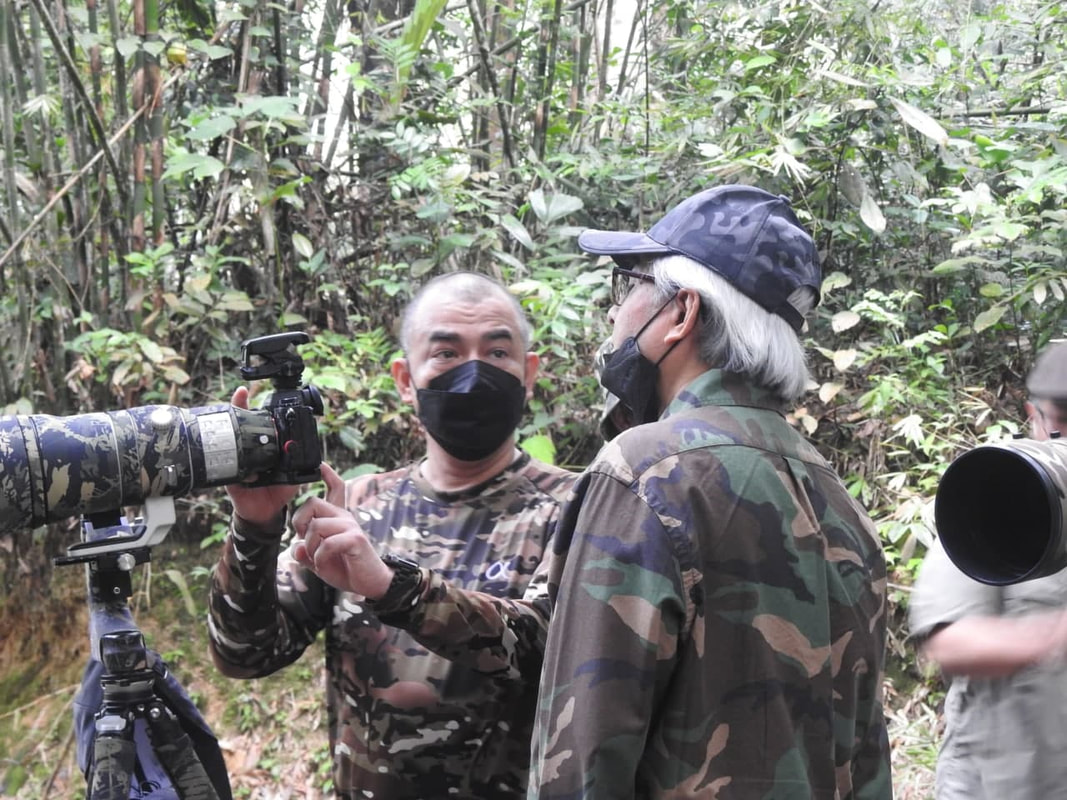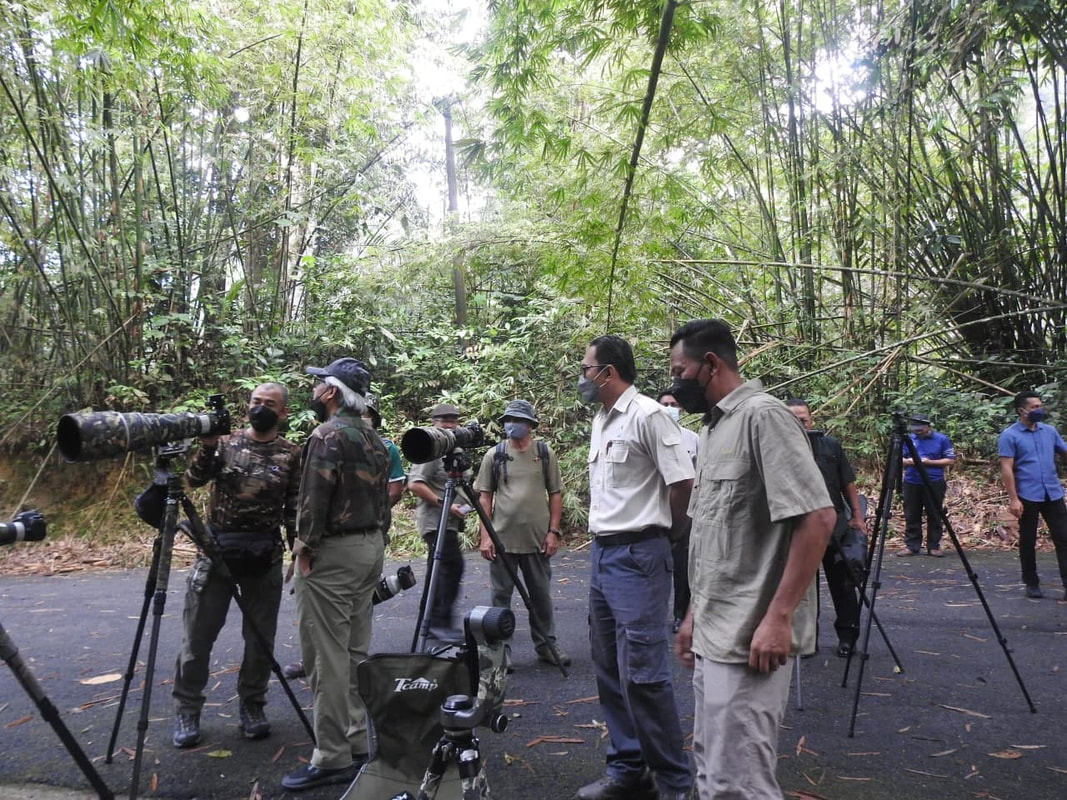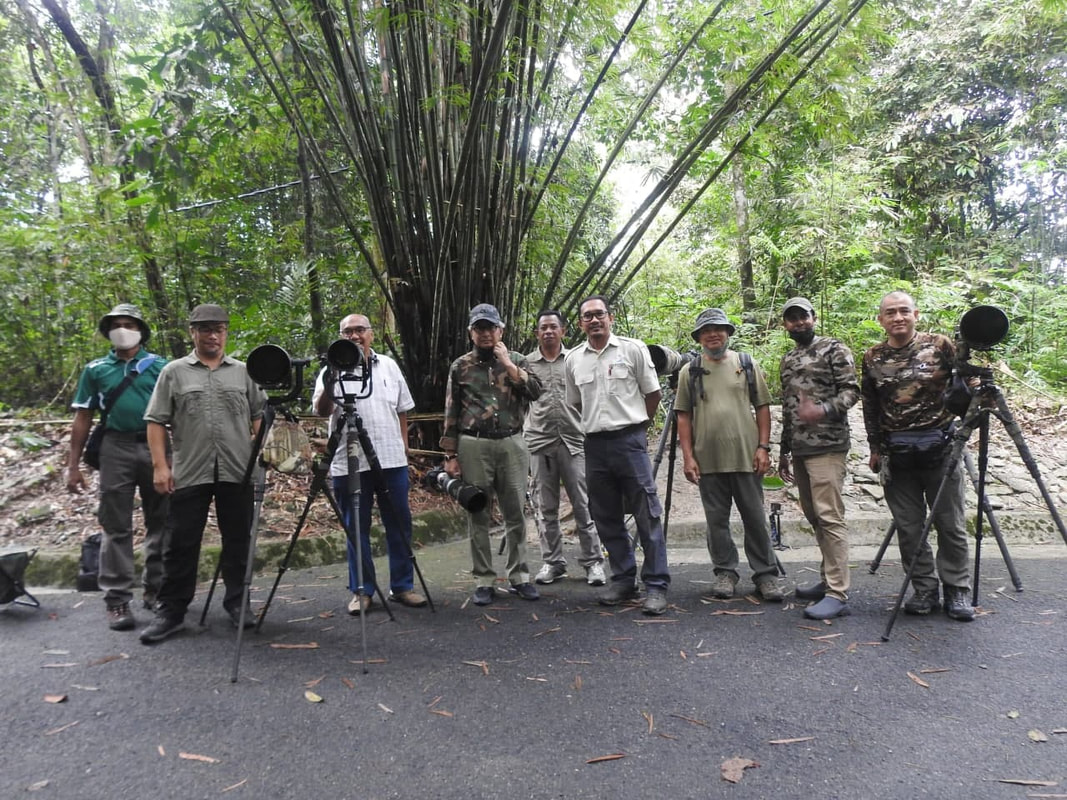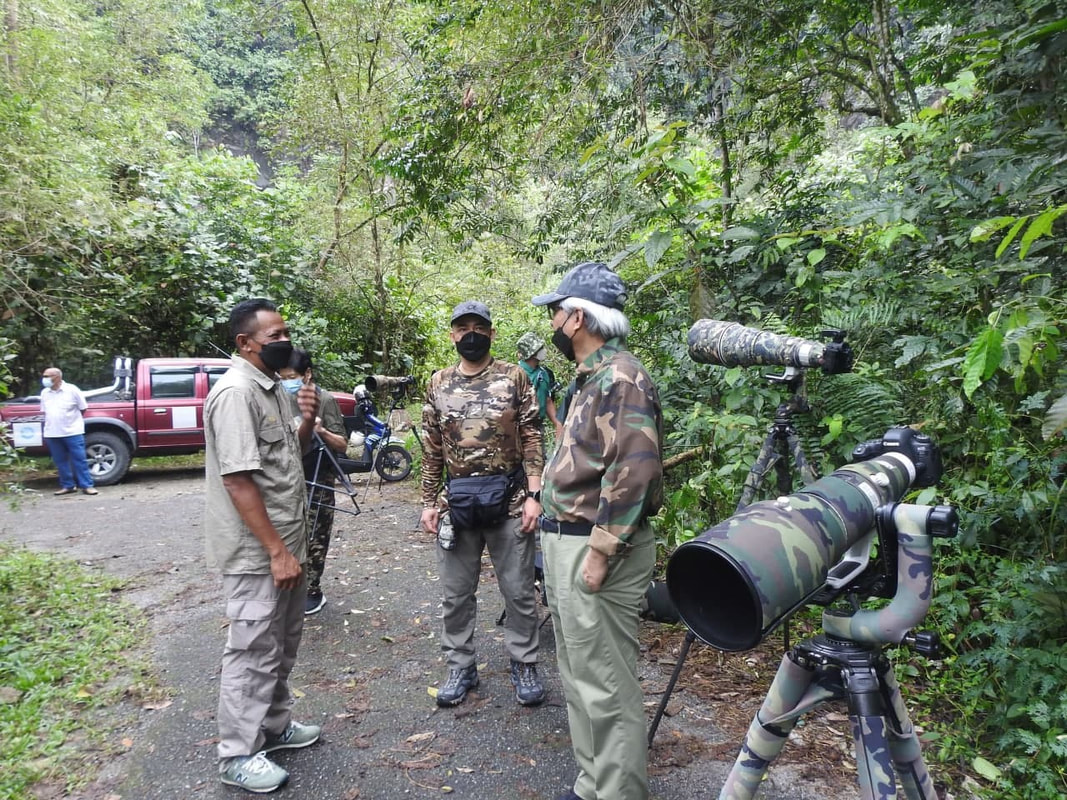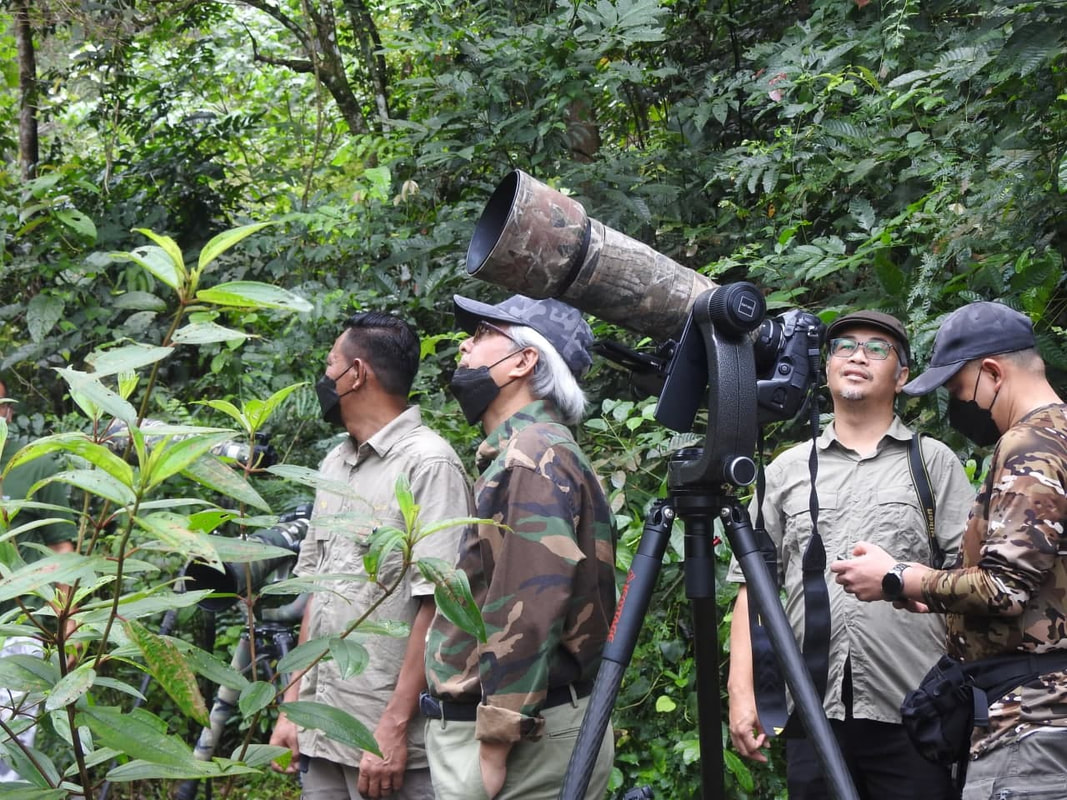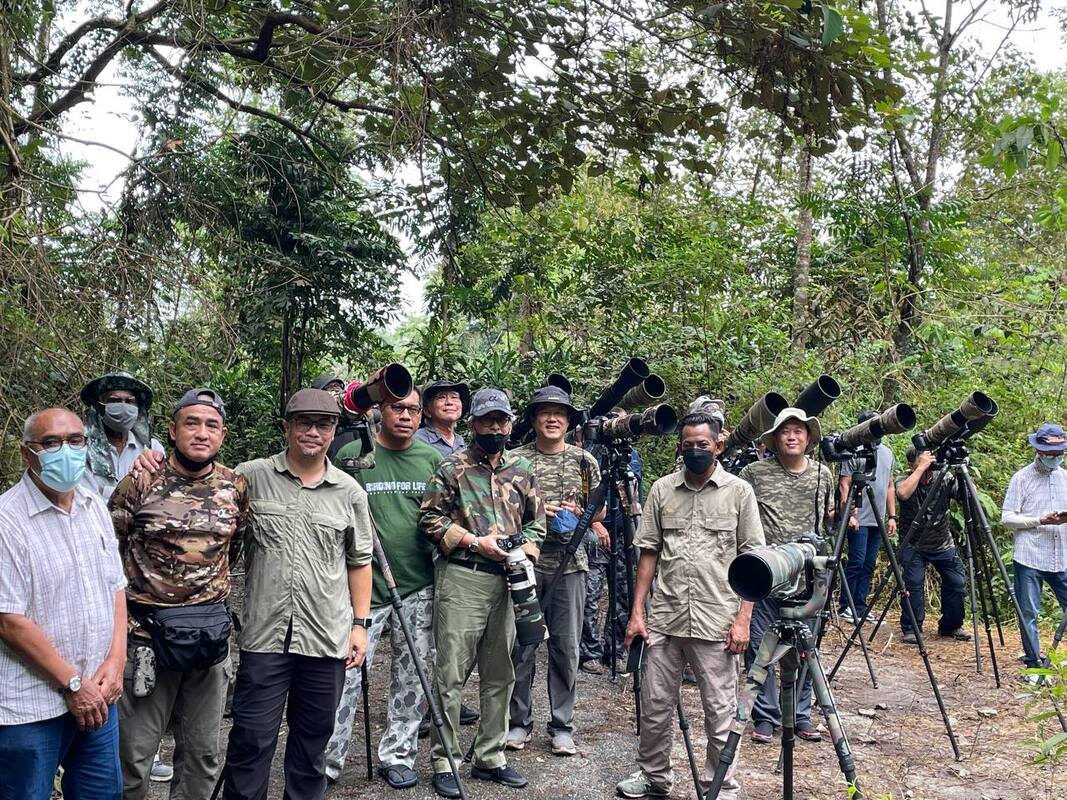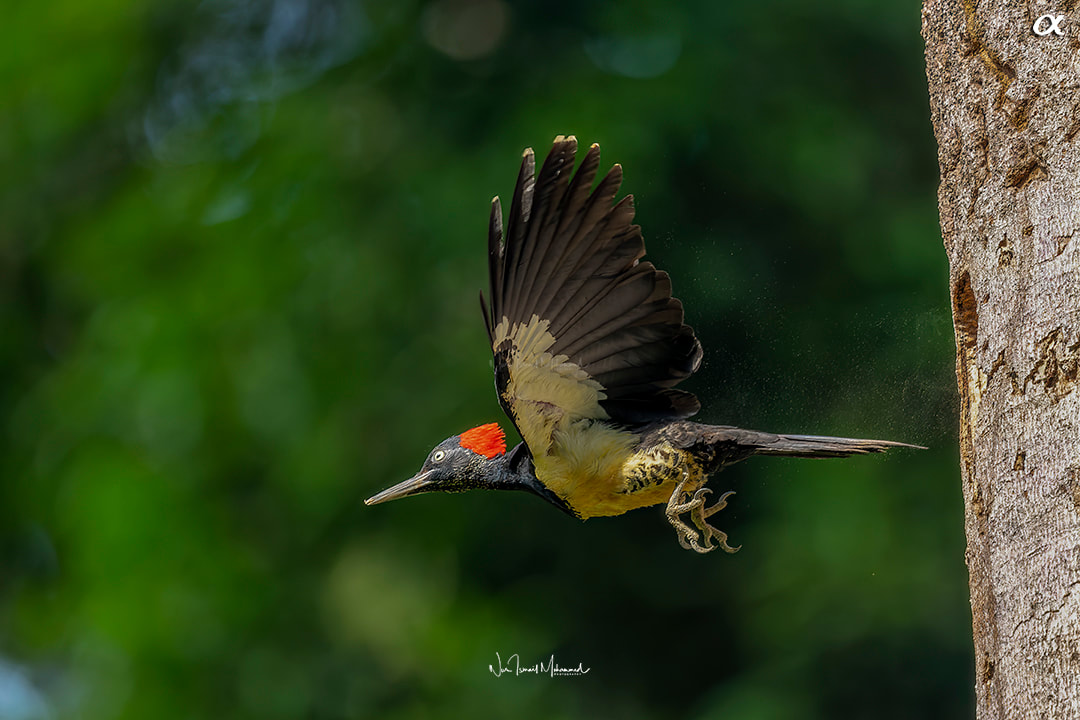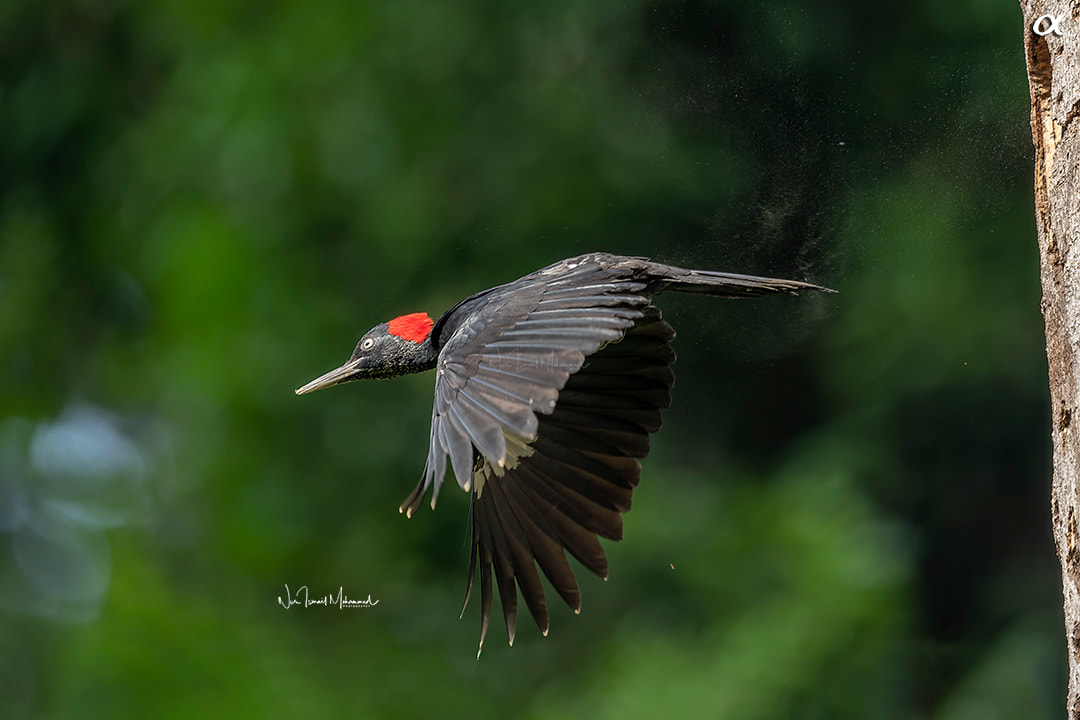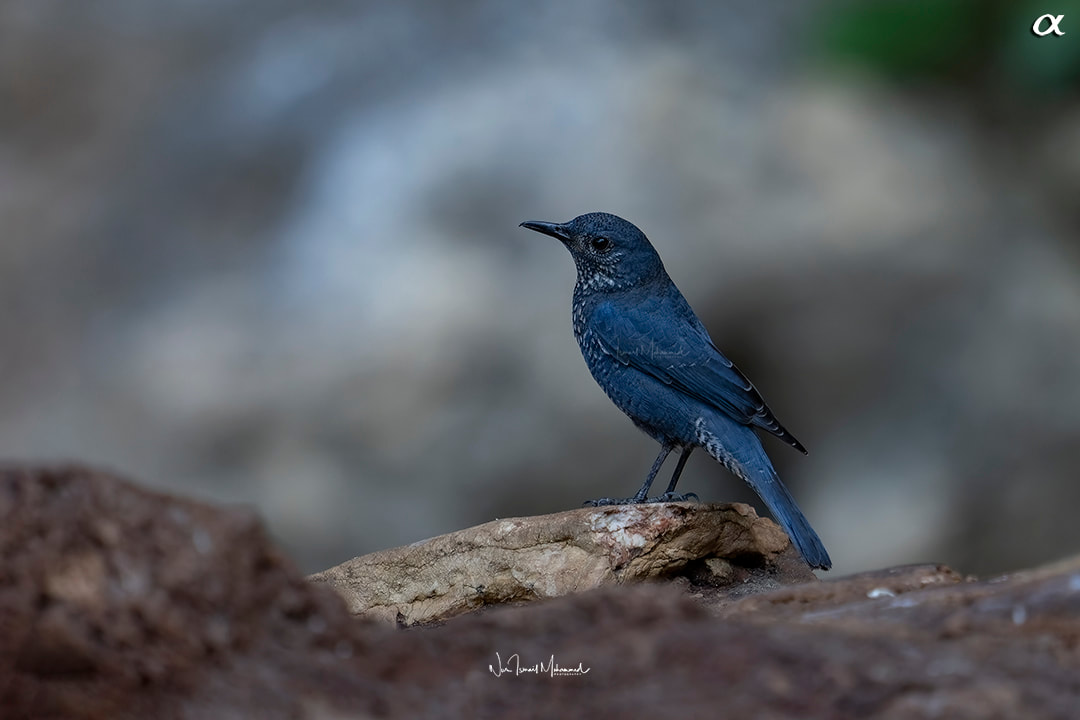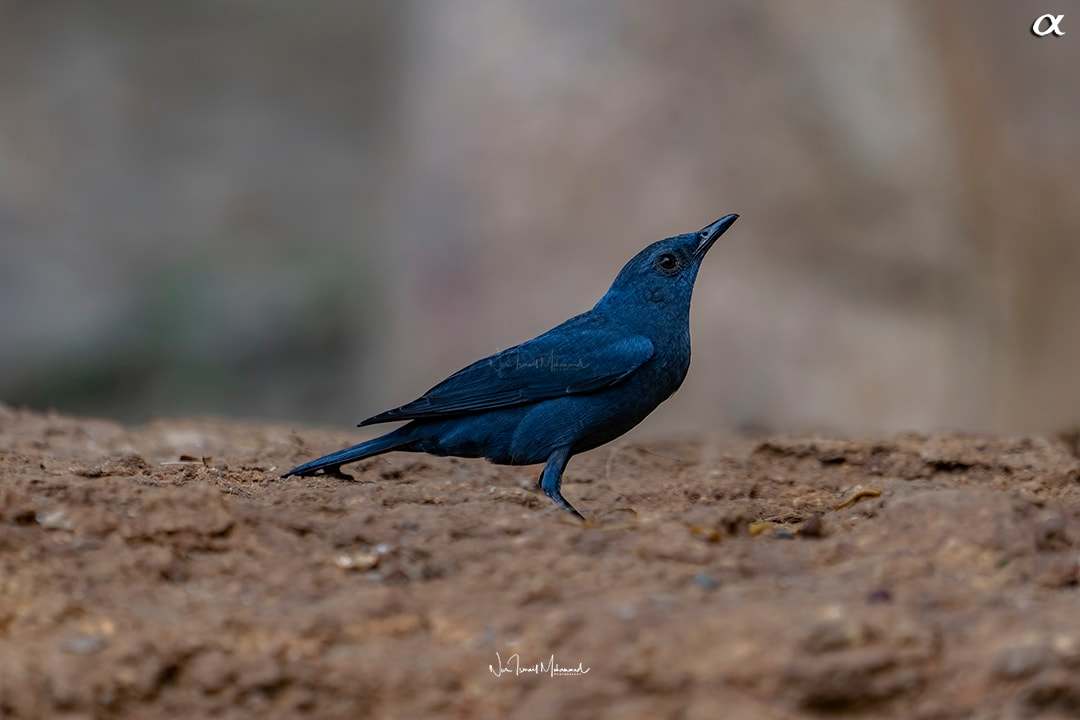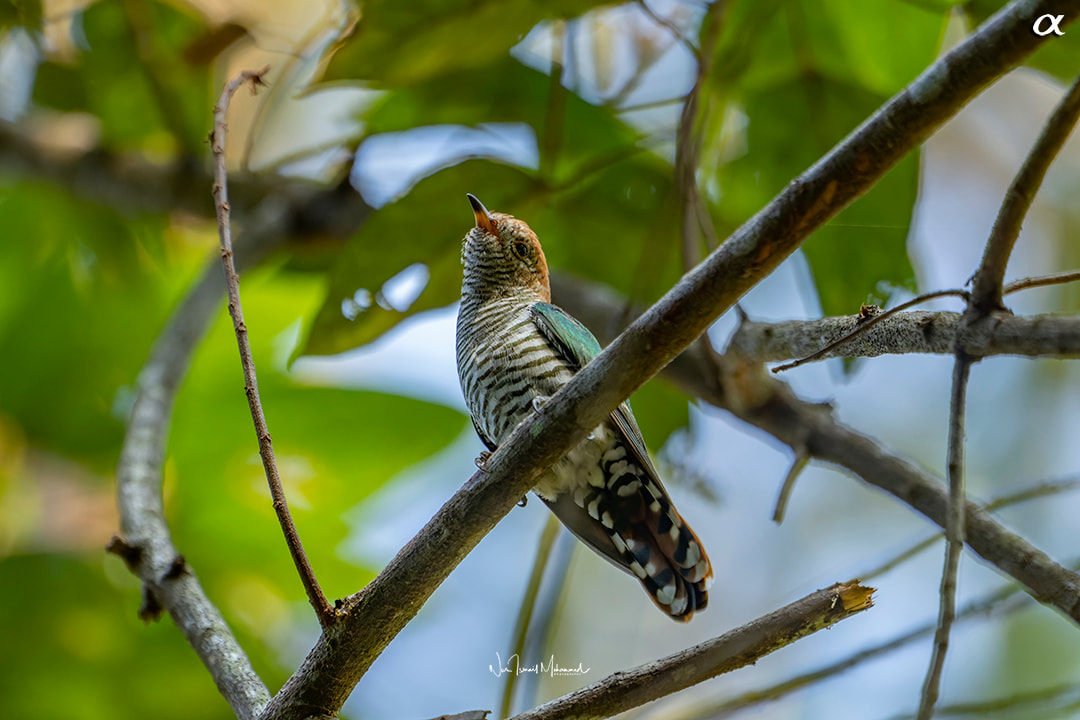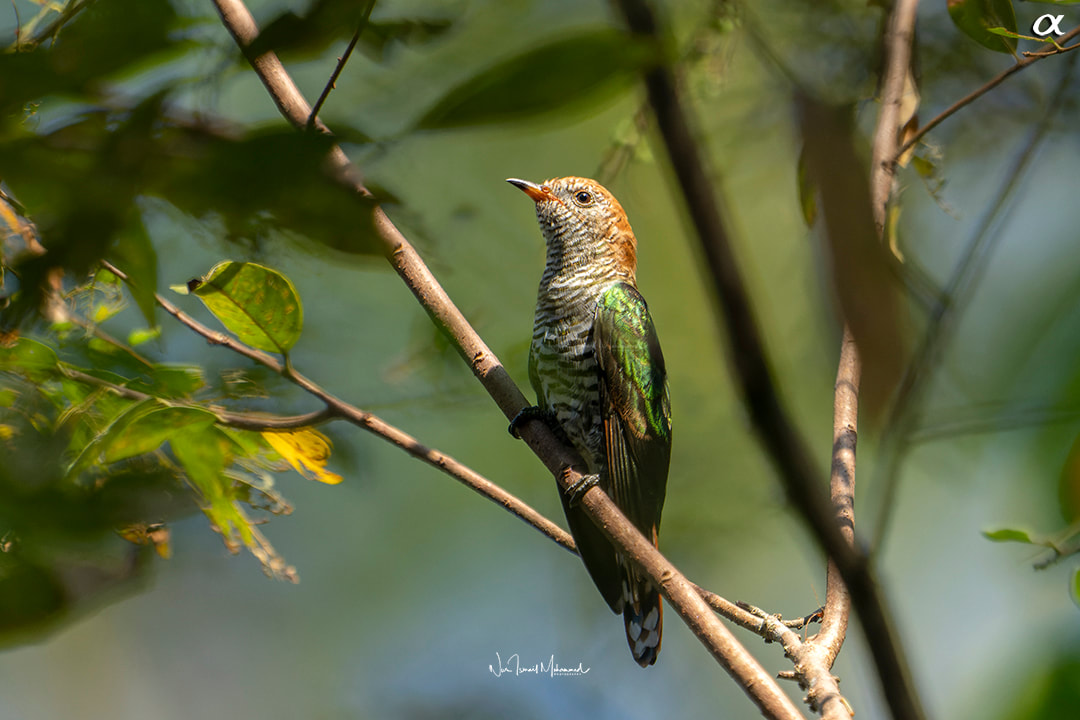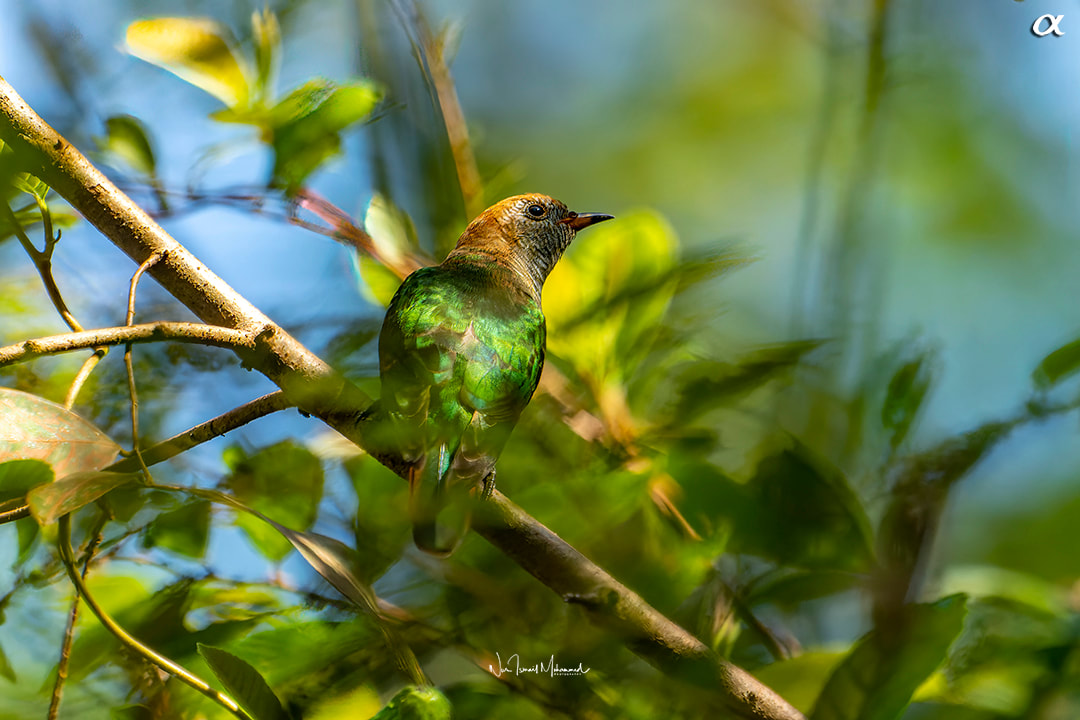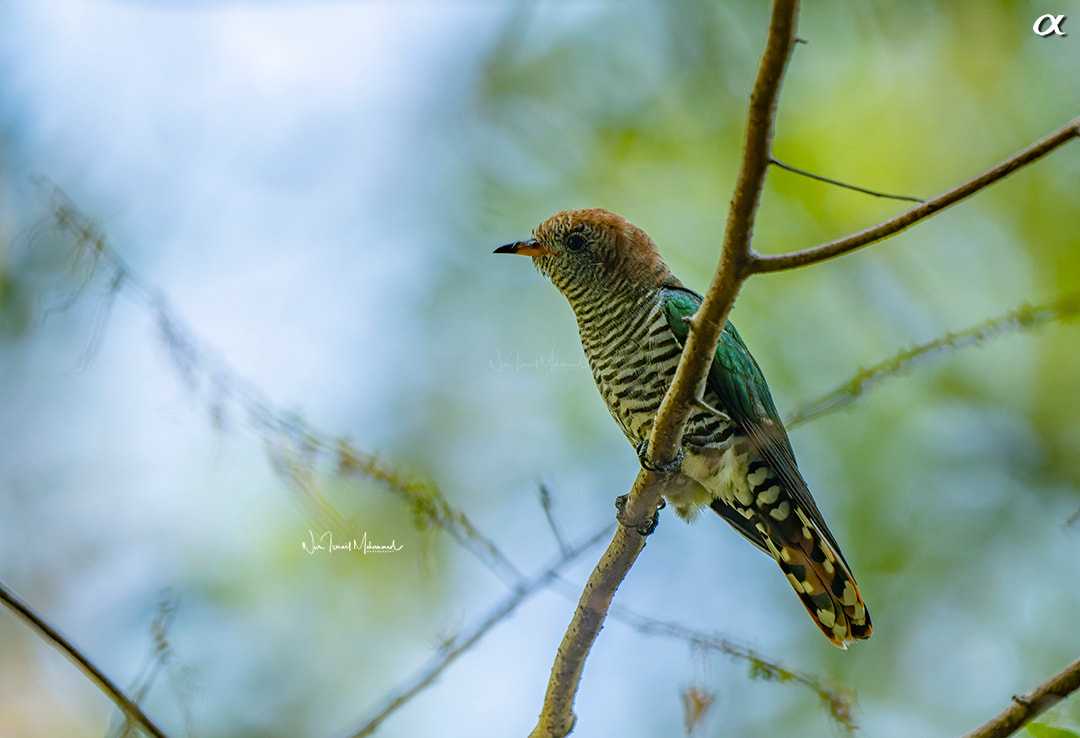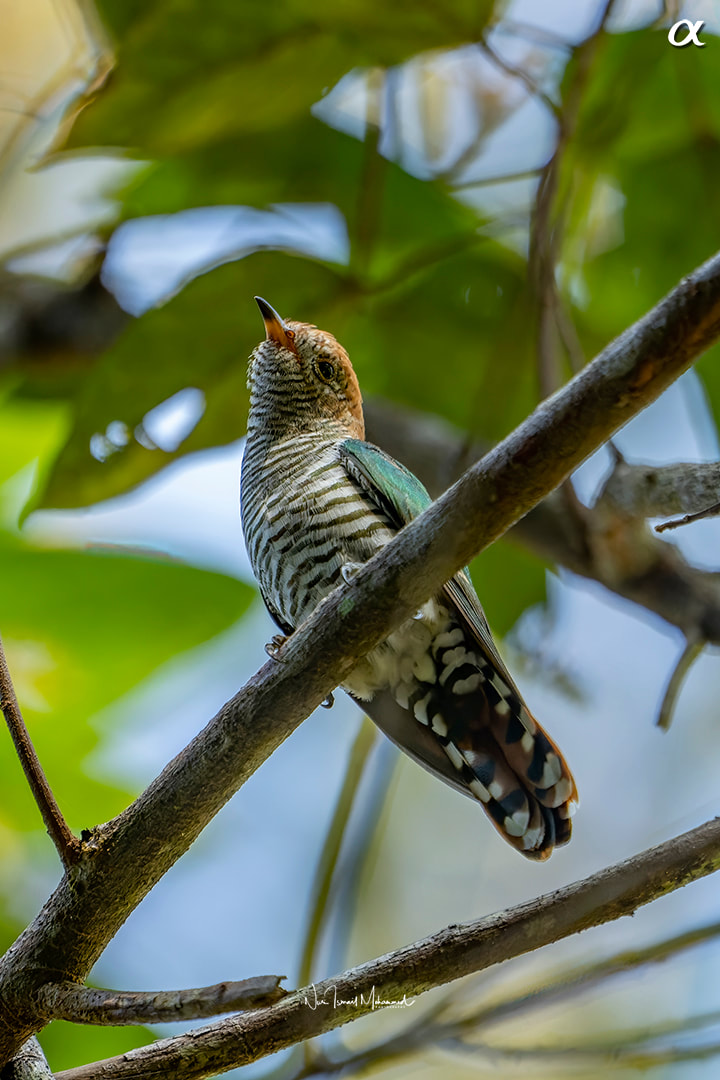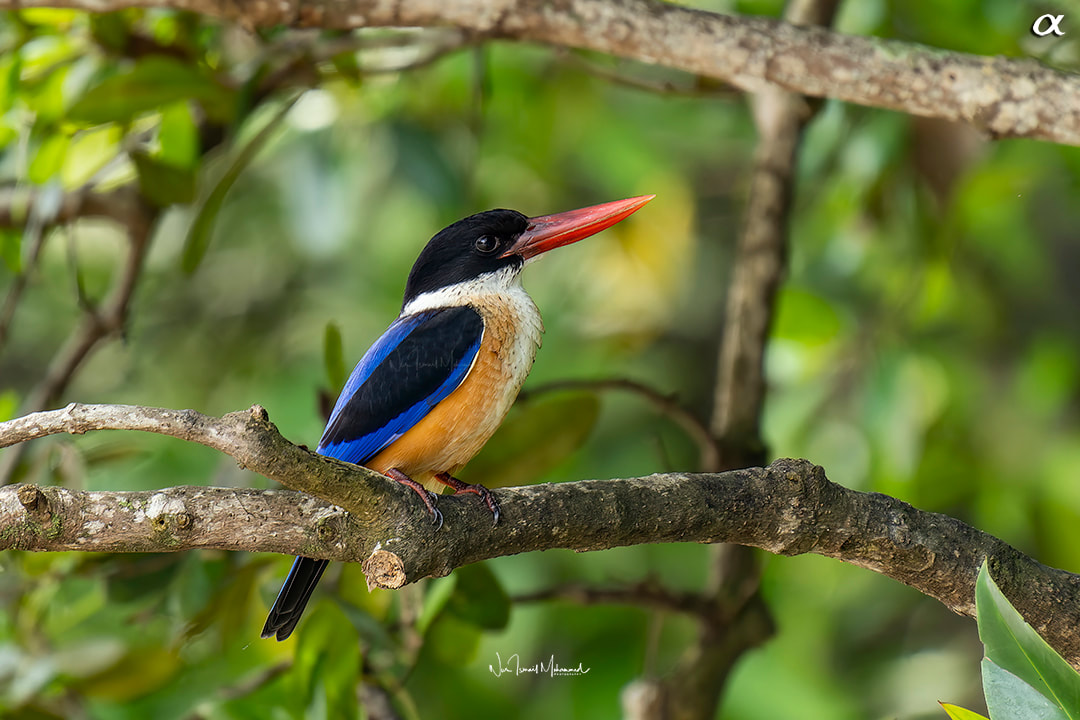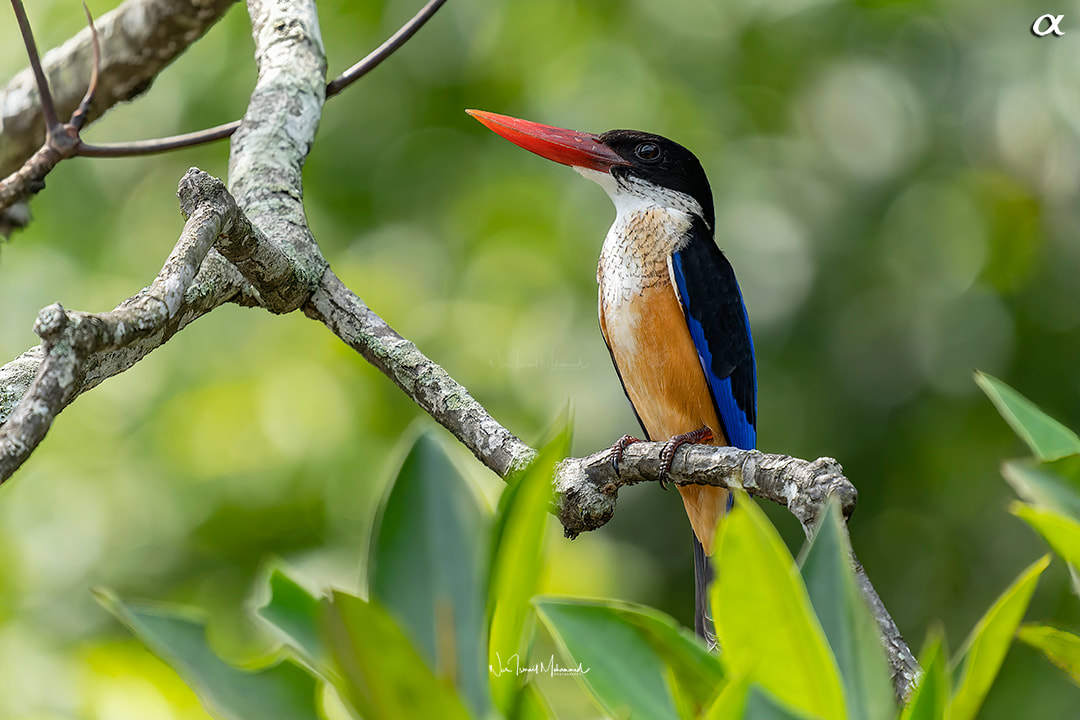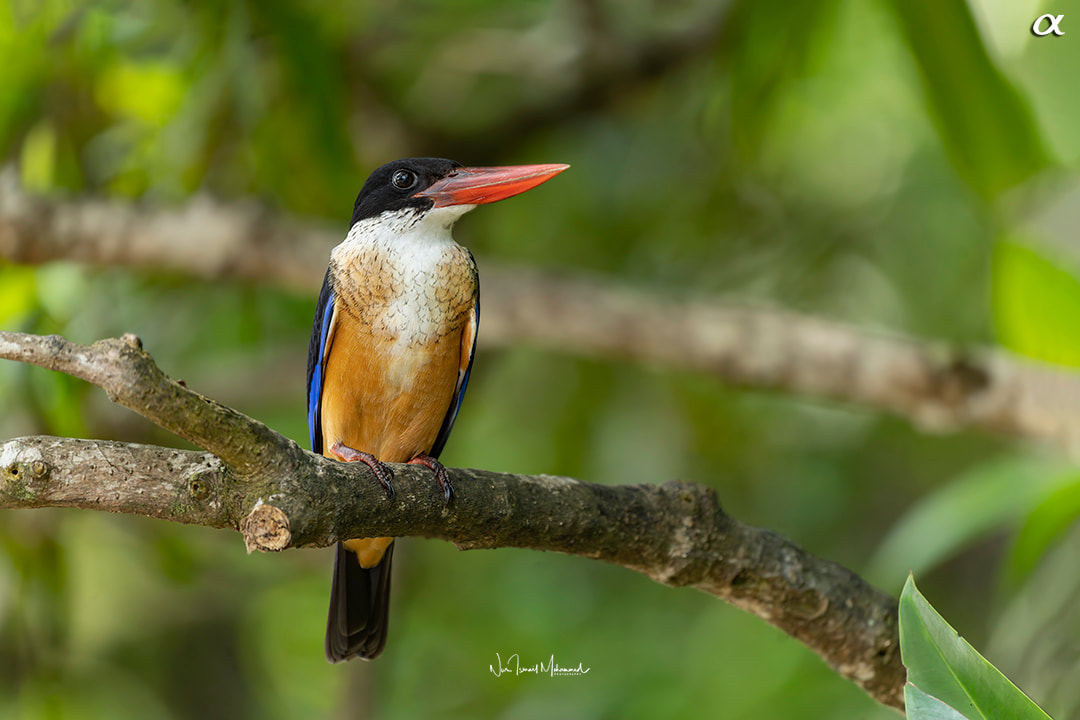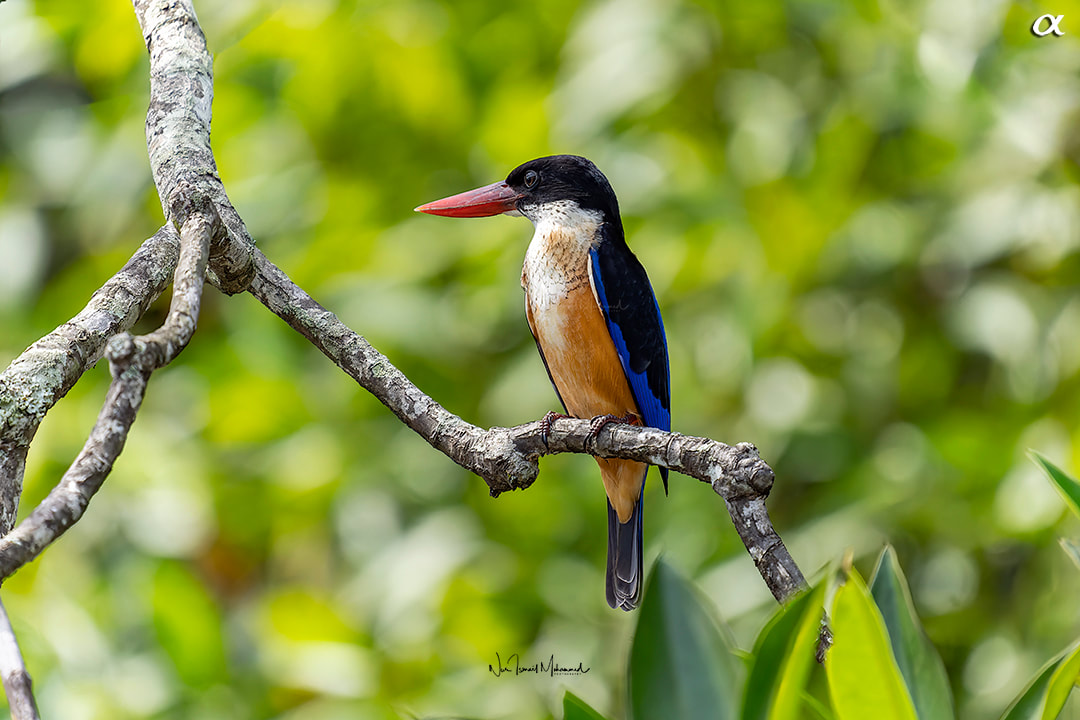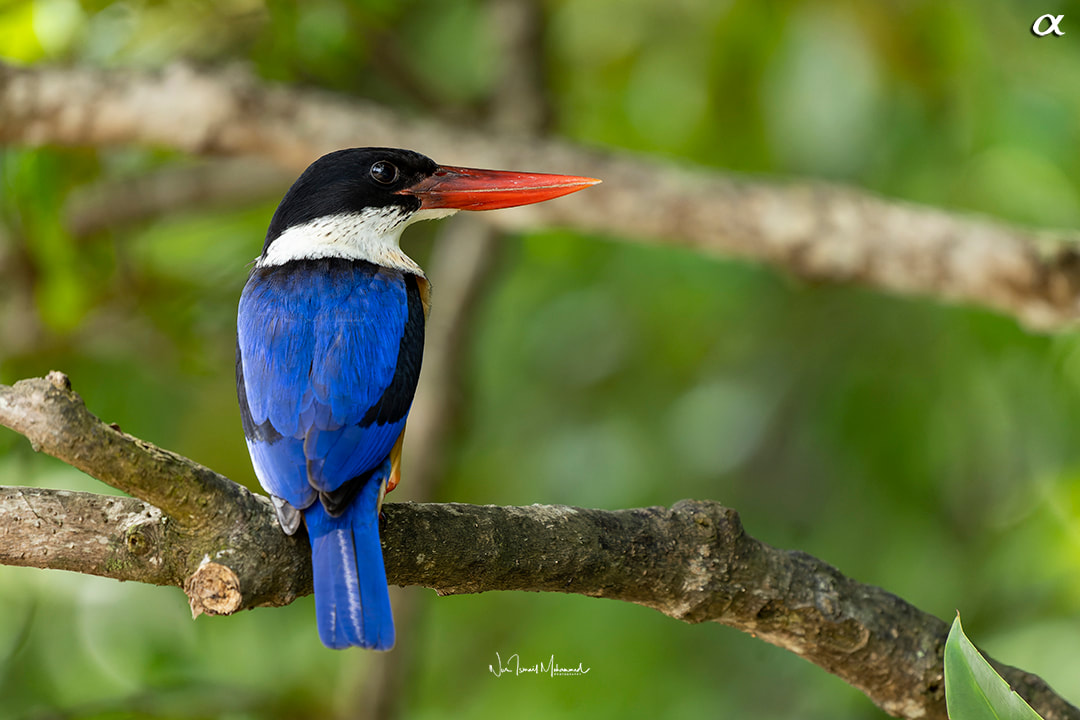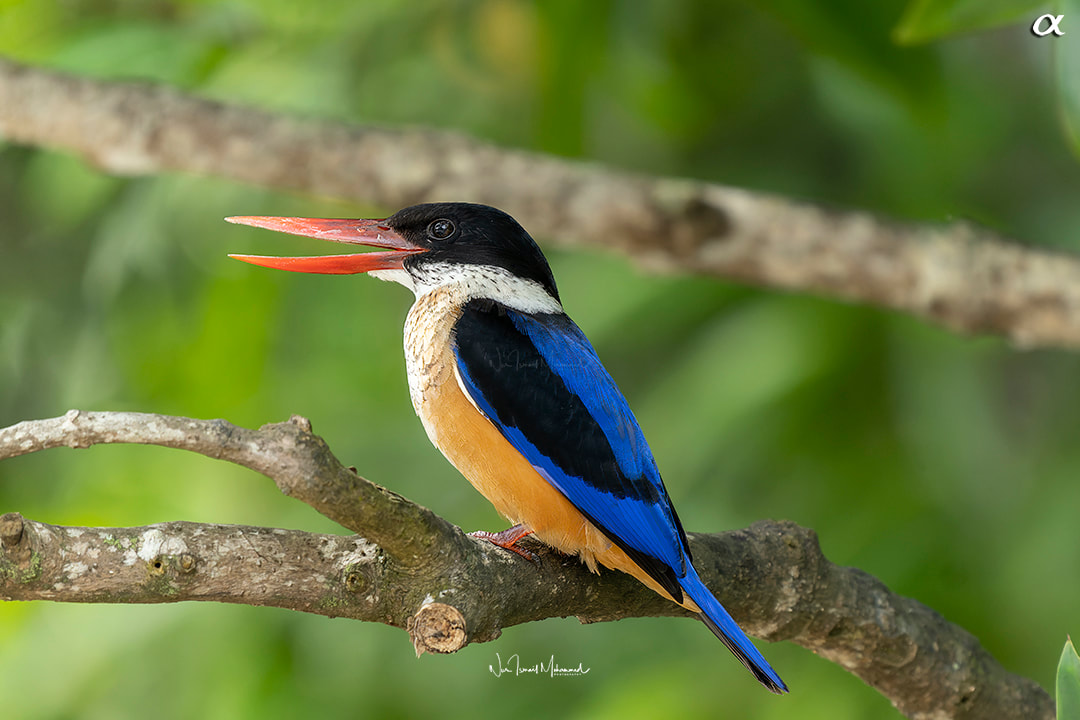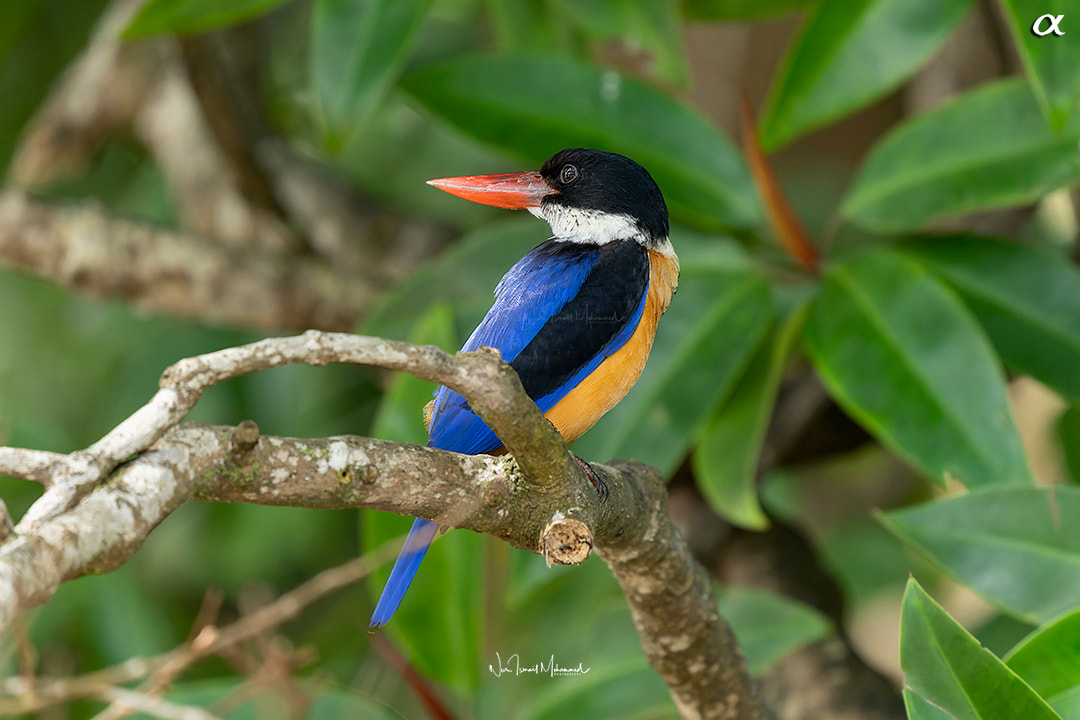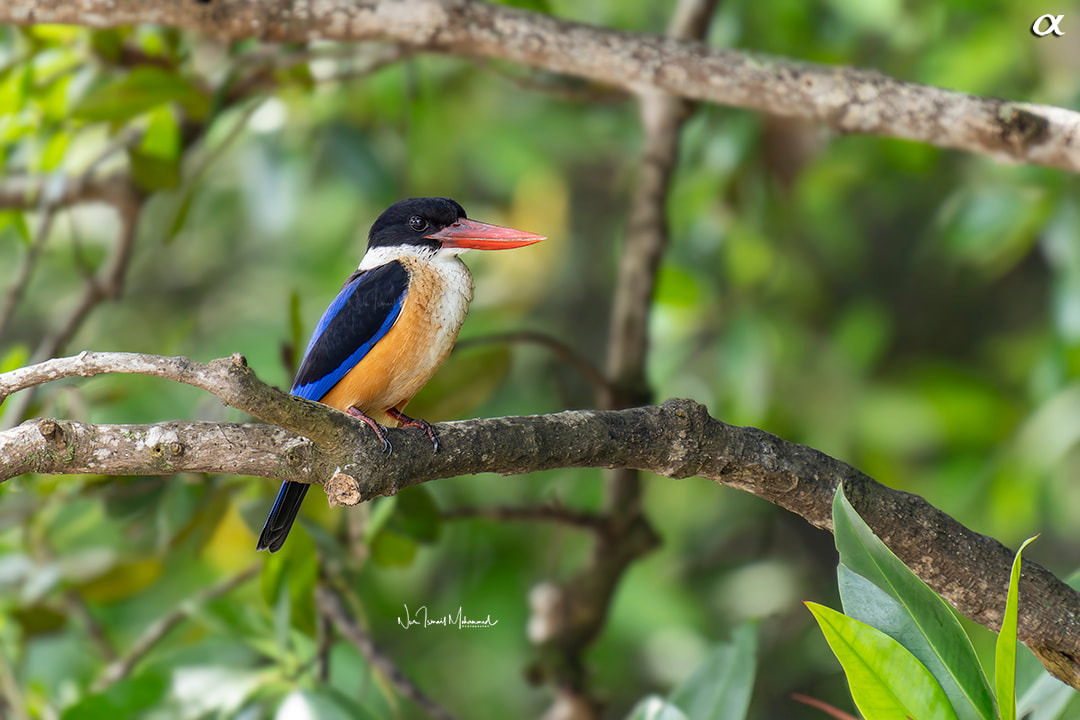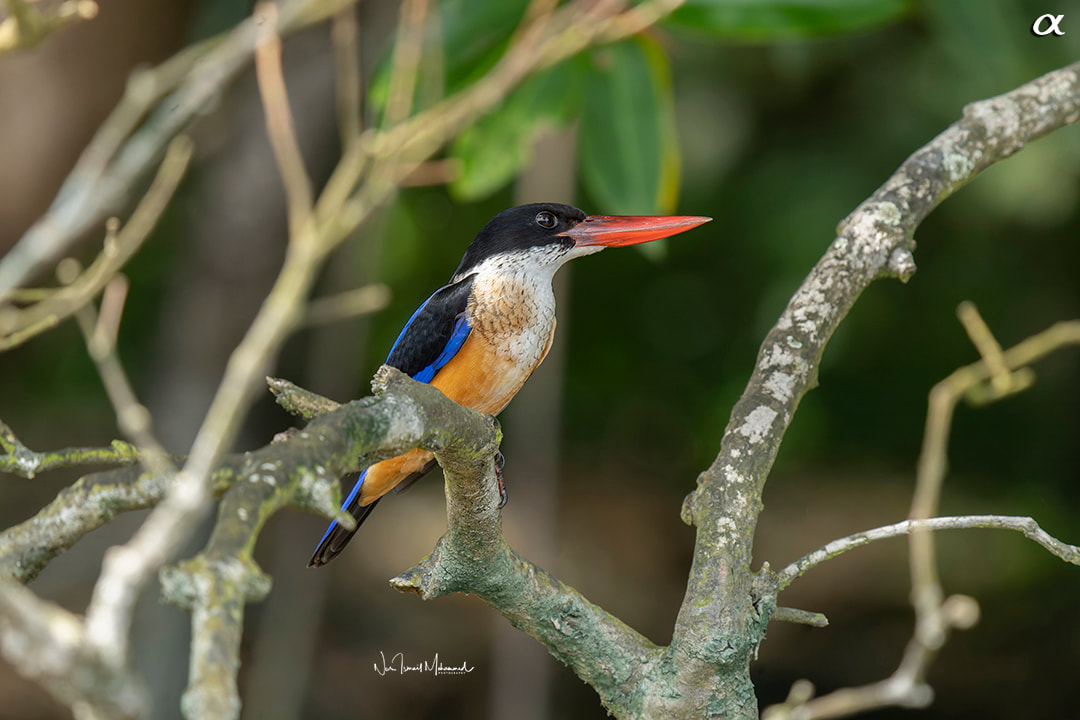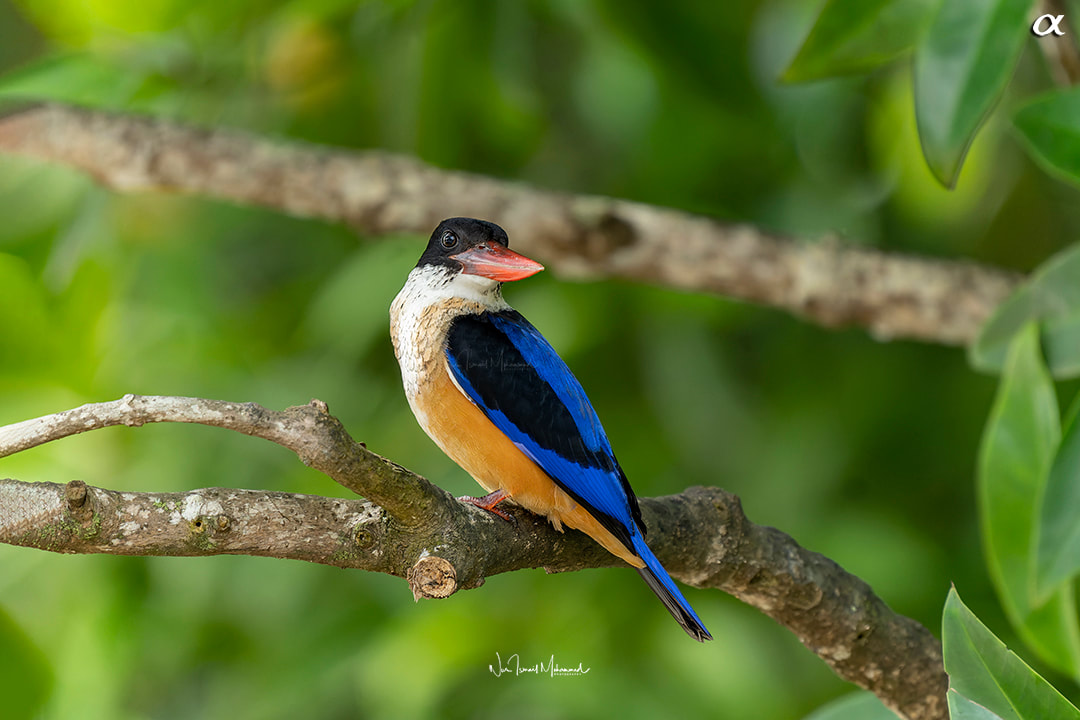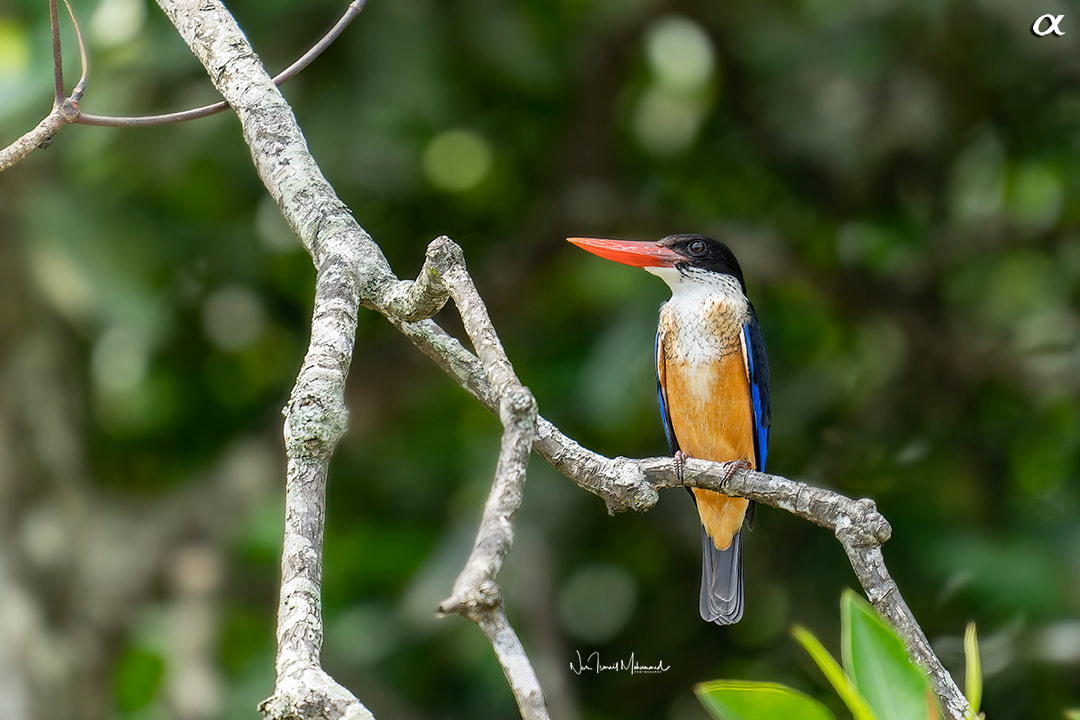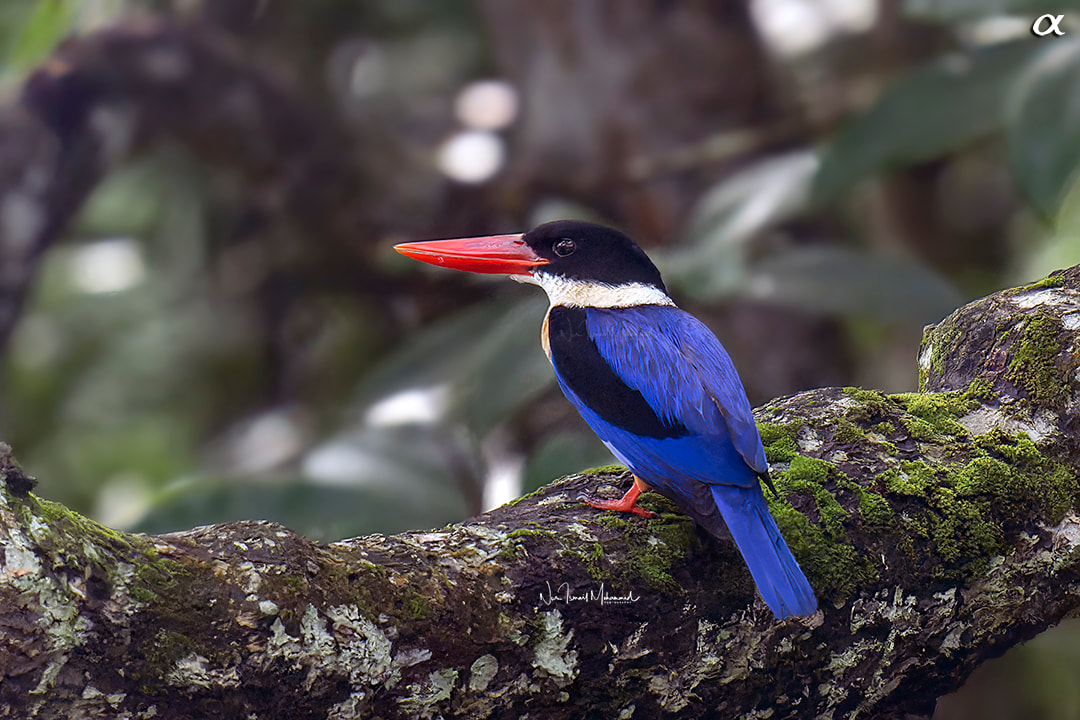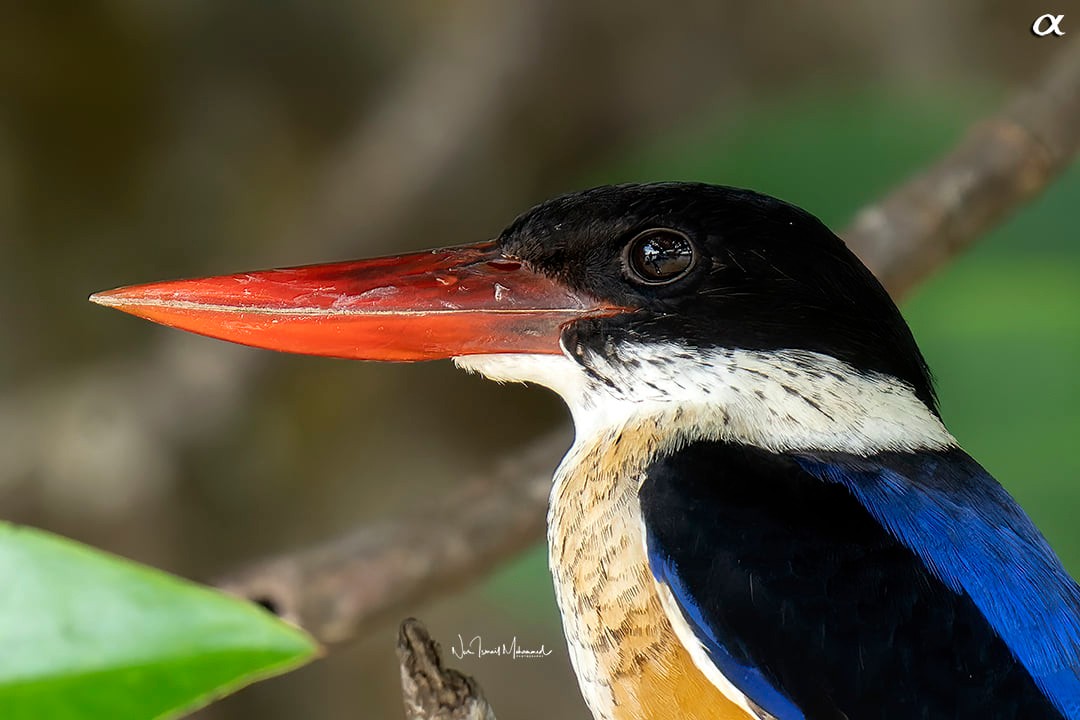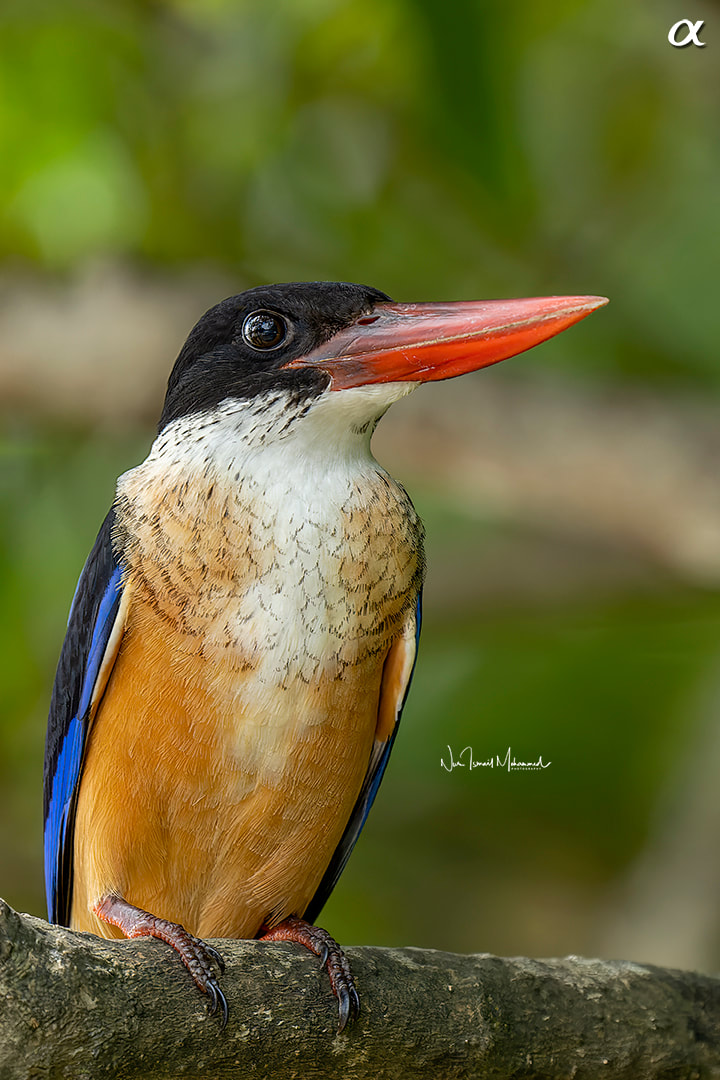|
Serilophus lunatus is a bird species from the broadbill family that is commonly known as Silver-breasted broadbill. This medium-sized bird measures about 16-17 cm in length and like to consume invertebrates, primarily insects such as grasshoppers, mantises, caterpillars, larvae and small land snails. It is found in the montane forest up to about 800-1,600 m, in the middle storey and forest edges. The Silver-breasted broadbill is monotypic as it is the only species within the genus Serilophus. It has a rusty-coloured head with an ash-grey forehead and a broad black supercilium (stripe) over its eyes. It also has white underpart, brilliant blue and yellow bill, black tail, bright rufous at the rump and upper wing coverts; and striking blue and black flight feathers. The female's appearance is similar to the male but with a narrow silvery white band across its breast, while the juvenile is slightly different and has shorter wings and tails with slightly darker plumage overall. [Source: MyBIS] Name: Silver-breasted broadbill Scientific: Serilophus lunatus Malay: Burung Tadah Hujan / Takau Dada-perak / Takau Tanda Hujan Family: Eurylaimidae IUCN Red List (v3.1, 2016): Least Concern Gear: SONY α1 + SEL200600G Location: Hulu Langat, Selangor, Malaysia #NurIsmailPhotography #sony #sonymalaysia #a1 #α1 #SEL200600G #alpha #AlphaGuru #SAG #DXO #PureRAW #topazlabs #leofoto #pg1 #Fight4ourPlanet #DiscoverWithMYAlpha #DiscoverWithAlpha #AlphaUniverseMY #FullFrameLife #MySONYLife
Copyright © 2022 Nur Ismail Photography. All rights reserved. Do not use or reproduce these images on websites, blogs or publications without expressed written permission from the photographer. For any enquiries, please visit my website: www.nurismailphotography.com or email at nismailm@gmail.com. Flickr: www.flickr.com/photos/nurismailphotography/
0 Comments
Psarisomus dalhousiae is the only species of the genus Psarisomus. Commonly known as Long-tailed broadbill, P. dalhousiae is a species of passerine birds that measuring about 25 cm in length and can be found in montane forests from about 800-2,000 m, in the canopy and middle storeys. This species normally travel in large, noisy groups except during mating seasons. The adult of Long-tailed broadbills has a brilliant green body with yellow face and throat, a bright yellowish-green bill, black cap and a blue crown and nape, and lime-coloured ear tufts. This species also has black wings with large blue patches that appear white when seen from below and long graduated blue tail. While the juveniles have a similar appearance to adults but are duller with a green head. [Source: MyBIS] The long-tailed broadbill is a forest bird that lives on insects. It is very sociable and normally travels in large, noisy parties except during the mating season. It builds a pear-shaped nest in a tree. The female usually lays between 5 and 6 eggs that are incubated by both sexes; both sexes also help to feed the young. The long-tailed broadbill is found in the Himalayas and Myanmar and discontinuously found through South-East Asia and the Malay Peninsula to Sumatra and Borneo. They are distributed in a variety of countries: India, Nepal, Bhutan, Myanmar, Thailand, Cambodia, Laos, Vietnam, China, Malaysia and Indonesia. They are commonly found in broad-leaved evergreen forests, ranging in altitudes from 150 to 2500 meters. Their natural habitats include: forests, streams and creeks, tropical and subtropical moist lowland forests, tropical and subtropical moist mountain forests. They seem to have a habitat preference nears small bodies of water such as streams, freshwater and wetlands. They are resident, non-migratory species. The populations of long-tailed broadbills that live in the higher altitudes of the Himalayas often move down to lower altitudes during cold winter months. The long-tailed broadbill's call is a series of loud, sharp, downward-inflected whistles, "pseeu..pseeu..pseeu" and "tseeay..tseeay" sounds on a descending scale. They may also make a sharp rasping "pseeup" sound. [Source: Wikipedia] Name: Long-tailed broadbill Scientific: Psarisomus dalhousiae Malay: Takau Ekor Panjag / Takau Injap Family: Eurylaimidae IUCN Red List (v3.1, 2016): Least Concern Gear: SONY α1 + SEL200600G Location: Pahang, Malaysia #NurIsmailPhotography #sony #sonymalaysia #a1 #α1 #SEL200600G #alpha #AlphaGuru #SAG #DXO #PureRAW #topazlabs #leofoto #pg1 #Fight4ourPlanet #DiscoverWithMYAlpha #DiscoverWithAlpha #AlphaUniverseMY #FullFrameLife #MySONYLife
Copyright © 2022 Nur Ismail Photography. All rights reserved. Do not use or reproduce these images on websites, blogs or publications without expressed written permission from the photographer. For any enquiries, please visit my website: www.nurismailphotography.com or email at nismailm@gmail.com. Flickr: www.flickr.com/photos/nurismailphotography/ The puff-throated babbler or spotted babbler (Pellorneum ruficeps) is a species of passerine bird found in Asia. They are found in scrub and moist forest mainly in hilly regions. They forage in small groups on the forest floor, turning around leaf litter to find their prey and usually staying low in the undergrowth where they can be hard to spot. They however have loud and distinct calls, including a morning song, contact and alarm calls. It is the type species of the genus Pellorneum which may however currently include multiple lineages. Puff-throated babblers are brown above, and white below with heavily brown streaks towards the breast and belly. They have a chestnut crown, long buff supercilium and dusky cheeks. The throat is white, and is sometimes puffed out giving it the English name. Puff-throated babblers have strong legs, and spend a lot of time on the forest floor. They can often be seen creeping through undergrowth in search of their insect food, looking at first glance like a song thrush. Some subspecies have streaks on the mantle while others, especially in Peninsular India, are unstreaked. This bird is a common resident breeder in the Himalayas and the forests of Asia. Like most babblers, it is not migratory, and has short rounded wings and a weak flight. Its habitat is scrub and bamboo thickets and forages by turning over leaves to find insects. Puff-throated babblers vocalize often. Their calls are a series of whistling notes ascending in scale. Some calls have been transcribed as he'll beat you, pret-ty-sweet. The calling can be persistent. The breeding season is mainly during the rainy season. They build a nest on the ground at the base of bush and is a dome of leaves and twigs with an entrance on the side. The opening usually points downhill when the nest is on sloping ground. The clutch varies from 2 to 5 eggs, with northern populations tending towards larger clutches. Parent birds run rodent-like in the undergrowth as they move in and out of the nest. Young birds fledge and leave the nest about 12 to 13 days after hatching. [Source: Wifipedia] Name: Puff-throated babbler Scientific: Pellorneum ruficeps Malay: Kekicau Tekak Kembang / Rimba Bintik-bintik Family: Pellorneidae IUCN Red List (v3.1, 2016): Least Concern Gear: SONY α1 + SEL200600G Location: Kedah, Malaysia #NurIsmailPhotography #sony #sonymalaysia #a1 #α1 #SEL200600G #alpha #AlphaGuru #SAG #DXO #PureRAW #topazlabs #leofoto #pg1 #Fight4ourPlanet #DiscoverWithMYAlpha #DiscoverWithAlpha #AlphaUniverseMY #FullFrameLife #MySONYLife
Copyright © 2022 Nur Ismail Photography. All rights reserved. Do not use or reproduce these images on websites, blogs or publications without expressed written permission from the photographer. For any enquiries, please visit my website: www.nurismailphotography.com or email at nismailm@gmail.com. Flickr: www.flickr.com/photos/nurismailphotography/ Banded pitta, scientifically known as Hydrornis irena is belongs to the family Pittidae. It can grow up to 23 cm. Both sexes have a clearly visible broad yellow supercilium which grades into the deep orange on the nape. They are also have a black central crown stripe, broad eye lines, a golden brown mantle, deep blue tail, white streaks on its wings and throat with a yellowish tinge on the sides of its neck. To differentiate both sexes, the male entire underparts are covered by dark blue with orange bands across the breast. Meanwhile, the female entire underparts are marked with narrower buff brown and black bands. H. irena forages in the ground storeys either singly or in pairs. This species is locally common at low elevations found in the Malay Peninsula, Sumatra, Borneo, and Java. [Source: MyBis] During the recent Chinese New Year holidays, I've made a trip to Kedah with my close friend Dr. Shaharudin Abdullah from Kuala Terengganu, to photograph the beautiful Malayan banded pitta. I was at the location for two days i.e. 1/2/2022 and 2/2/2022 and thankfully, managed to photograph the pitta on both days. Looking at it for the first time with our own eyes gave us the sense of awe to be able to witness such a beautiful bird. Only the male pitta came out to feed on the meal worms. Female pitta never showed up. I am pretty sure this will not be the last visit to Kedah. There are other target birds that I didn't manage to photograph, like the chestnut-necklaced partridge, Blyth's frogmouth and white-crowned hornbill. It was unfortunate that the bird guide that we have booked, decided not to guide us a week before my trip, for whatever reason. So, being the first time birding in Kedah, I could not get all the target birds that I wanted. Luckily, a nice gentleman helped me to find the pitta port. In sya Allah, I'll be back there again, with a proper bird guide! Name: Malayan banded pitta (male) Scientific: Hydrornis irena Malay: Burung Pacat Belang Malaya / Burung Pacat Berjalur Family: Pittidae IUCN Red List (v3.1, 2016): Near Threatened Gear: SONY α1 + SEL200600G Lokasi: Kedah #NurIsmailPhotography #sony #sonymalaysia #a1 #α1 #SEL200600G #alpha #AlphaGuru #SAG #DXO #PureRAW #topazlabs #leofoto #pg1 #Fight4ourPlanet #DiscoverWithMYAlpha #DiscoverWithAlpha #AlphaUniverseMY #FullFrameLife #MySONYLife
Copyright © 2022 Nur Ismail Photography. All rights reserved. Do not use or reproduce these images on websites, blogs or publications without expressed written permission from the photographer. For any enquiries, please visit my website: www.nurismailphotography.com or email at nismailm@gmail.com. Flickr: www.flickr.com/photos/nurismailphotography/ Hemiprocne comata or known as Whiskered treeswift is species of bird in the Hemiprocnidae family. This bird has a small size body measuring about 15 cm in length and a glossy blue-black headwith chestnut ear coverts (Strange & Jeyarajasingam, 1993). The upperparts and underparts of the male are generally yellowish- brown. The female look similar with the male but lacks chestnut ear coverts. Whiskered treeswift can easily be distinguished by its small size and white facial stripes on its head. This swift is common in Peninsular Malaysia and throughout much of South- East Asia. It can be seen in lowland rainforest up montane forest up to 1, 100 m above sea level (Jeyarajasingam & Pearson, 2012). [Source: MyBis] I've made a trip to Sg. Sedim Resort (near Kulim in Kedah) end January 2022 and this time around, I've managed to improve my shots of the whiskered treeswift, mostly eye-level shots. Name: Whiskered treeswift (male) Scientific: Hemiprocne comata Malay: Layang-layang Jambul Kecil / Lelayang Pokok Kecil Family: Hemiprocnidae IUCN Red List (v3.1, 2016): Least Concern Gear: SONY α1 + SEL200600G + SEL14TC Location: Sg. Sedim, Kedah #NurIsmailPhotography #sony #sonymalaysia #a1 #α1 #SEL200600G #SEL14TC #alpha #AlphaGuru #SAG #DXO #PureRAW #topazlabs #leofoto #pg1 #Fight4ourPlanet #DiscoverWithMYAlpha #DiscoverWithAlpha #AlphaUniverseMY #FullFrameLife #MySONYLife
Copyright © 2022 Nur Ismail Photography. All rights reserved. Do not use or reproduce these images on websites, blogs or publications without expressed written permission from the photographer. For any enquiries, please visit my website: www.nurismailphotography.com or email at nismailm@gmail.com. Flickr: www.flickr.com/photos/nurismailphotography/ I had the pleasure and privilege of accompanying Duli Yang Amat Mulia Raja Di-Hilir Perak Raja Iskandar Zulkarnain ibni Almarhum Sultan Idris Iskandar Al-Mutawakkil Alallahi Shah Afifurlah on His Royal Highness ("HRH") visit to Taiping on 26 January 2022. It is indeed an important occasion for Taiping, especially to the birding community and nature lovers. HRH is known for his love for nature and wildlife photography, brought with him SONY Alpha 1 mirrorless camera and the SONY FE 200-600mm F/5.6-6.3 G OSS lens for the occasion. HRH visited two of the most popular birding spots in Taiping and was amazed at the number of bird photographers from outside of Taiping came to photograph the birds. The entourage was then taken to Zoo Taiping & Night Safari for a tour of the zoo, led by its director, Dr. Kevin Lazarus. HRH is very supportive of this birding activity and hopes that it will become a national industry especially for the state of Perak. Daulat Tuanku! #NurIsmailPhotography #sony #sonymalaysia #a1 #α1 #SEL600F40GM #alpha #AlphaGuru #SAG #DXO #PureRAW #topazlabs #leofoto #pg1 #Fight4ourPlanet #DiscoverWithMYAlpha #DiscoverWithAlpha #AlphaUniverseMY #FullFrameLife #MySONYLife
Dryocopus javensis is a large-sized woodpecker measuring about 43 cm in length (Strange & Jeyarajasingam, 1993). It is commonly known as White bellied woodpecker or Belatuk hitam putih in Malay. This species can be found in lowland rainforest of Peninsular Malaysia as well as the secondary growth and mangroves (Strange & Jeyarajasingam, 1993). It often moves in pair (Jeyarajasingam & Pearson, 2012). In general, the White bellied woodpecker has a black plumage with white belly and red crest in both sexes. The males can easily be identified by the red malar stripe and crown. In contrast with the male appearance, the females have a black crown but lack red malar stripe. [Source: MyBIS]. Name: White-bellied woodpecker (male) Scientific: Dryocopus javensis Malay: Belatok Gajah / Belatuk Gajah / Belatuk Hitam Putih / Belatuk Perut Putih Family: Picidae IUCN Red List (v3.1, 2016): Least Concern Gear: SONY a1 + SEL600F40GM Location: Hulu Langat #NurIsmailPhotography #sony #sonymalaysia #a1 #α1 #SEL600F40GM #alpha #AlphaGuru #SAG #DXO #PureRAW #topazlabs #leofoto #pg1 #Fight4ourPlanet #DiscoverWithMYAlpha #DiscoverWithAlpha #AlphaUniverseMY #FullFrameLife #MySONYLife
Copyright © 2021 Nur Ismail Photography. All rights reserved. Do not use or reproduce these images on websites, blogs or publications without expressed written permission from the photographer. For any enquiries, please visit my website: www.nurismailphotography.com or email at nismailm@gmail.com. Flickr: www.flickr.com/photos/nurismailphotography/ The blue rock thrush (Monticola solitarius) is a species of chat. This thrush-like Old World flycatcher was formerly placed in the family Turdidae. It breeds in southern Europe, northwest Africa, and from Central Asia to northern China and Malaysia. The blue rock thrush is the official national bird of Malta and was shown on the Lm 1 coins that were part of the country's former currency. The blue rock thrush is a starling-sized bird, 21–23 cm (8.3–9.1 in) in length with a long slim bill. The breeding male of the nominate subspecies is unmistakable, with all blue-grey plumage apart from its darker wings. Females and immatures are much less striking, with dark brown upperparts, and paler brown scaly underparts. The male of the subspecies M. s. philippensis has rufous-chestnut plumage from the mid-breast down to the undertail. Both sexes lack the reddish outer tail feathers of rock thrush. The male blue rock thrush sings a clear, melodious call that is similar to, but louder than the call of the rock thrush. [Source: Wikipedia] Name: Blue rock thrush Scientific: Monticola solitarius Malay: Burung Tarum / Murai Batu Tarung / Murai Tarum / Murai Tarum Biru Family: Turdidae IUCN Red List (v3.1, 2016): Least Concern Gear: SONY α1 + SEL600F40GM Location: Ipoh, Perak #NurIsmailPhotography #sony #sonymalaysia #a1 #α1 #SEL600F40GM #alpha #AlphaGuru #SAG #DXO #PureRAW #topazlabs #leofoto #pg1 #Fight4ourPlanet #DiscoverWithMYAlpha #DiscoverWithAlpha #AlphaUniverseMY #FullFrameLife #MySONYLife
Copyright © 2021 Nur Ismail Photography. All rights reserved. Do not use or reproduce these images on websites, blogs or publications without expressed written permission from the photographer. For any enquiries, please visit my website: www.nurismailphotography.com or email at nismailm@gmail.com. Flickr: www.flickr.com/photos/nurismailphotography/ The Asian emerald cuckoo (Chrysococcyx maculatus) is a species of cuckoo in the family Cuculidae. It is found in Bangladesh, Bhutan, Cambodia, China, India, Indonesia, Laos, Malaysia, Myanmar, Nepal, Sri Lanka, Thailand, and Vietnam. Its natural habitats are subtropical or tropical moist lowland forests and subtropical or tropical moist montane forest. The Asian emerald cuckoo grows to a length of about 18 cm (7 in). The adult male has an iridescent dark green head, upper parts and upper breast, a white lower breast and a green barred belly. Bare skin round the eye is orange and the beak is orange/yellow tipped with black. The adult female has coppery-green upper parts, rusty brown crown and nape and green-barred underparts. Both sexes show a white band on the underwing when in flight. The underparts of the juvenile male lack the white lower breast and are more heavily barred. The voice is a “chweek” uttered while flying, and various whistled twitters. This cuckoo has a breeding range that extends from the Himalayas eastwards to Myanmar, China and northern Thailand. Further south it is a vagrant or migrant in northern India, Sri Lanka, Malaysia and Sumatra; it is not known to breed in these areas. It frequents forests and woodland margins. The Asian emerald cuckoo mainly forages in the upper levels of the canopy where it feeds on insects and other small invertebrates, including ants, caterpillars and bugs. It is a brood parasite, the females laying their eggs in the nests of other birds, such as the crimson sunbird (Aethopyga siparaja) and the little spiderhunter (Arachnothera longirostra). [Source: Wikipedia] Name: Asian emerald cuckoo (female) Scientific: Chrysococcyx maculatus Malay: Sewah Hijau / Sewah Tanah Family: Cuculidae IUCN Red List (v3.1, 2018): Least Concern Gear: SONY a1 + SEL600F40GM + SEL14TC. #NurIsmailPhotography #sony #sonymalaysia #a1 #SEL600F40GM #alpha #AlphaGuru #SAG #DXO #PureRAW #topazlabs #leofoto #pg1 #Fight4ourPlanet #DiscoverWithMYAlpha #DiscoverWithAlpha #AlphaUniverseMY #FullFrameLife #MySONYLife
Copyright © 2021 Nur Ismail Photography. All rights reserved. Do not use or reproduce these images on websites, blogs or publications without expressed written permission from the photographer. For any enquiries, please visit my website: www.nurismailphotography.com or email at nismailm@gmail.com. Flickr: www.flickr.com/photos/nurismailphotography/ The black-capped kingfisher (Halcyon pileata) is a tree kingfisher which is widely distributed in tropical Asia from India east to China, Korea and Southeast Asia. This most northerly of the tree kingfishers is resident over much of its range, but northern populations are migratory, wintering south of their range in Sri Lanka, Thailand, Borneo and Java. It is distinctive in having a black cap that contrasts with the whitish throat, purple-blue wings and the coral red bill. The species is mainly found in coastal and mangrove habitats but can sometimes be found far inland. This kingfisher is about 28 centimetres (11 in) long. The adult has purple-blue wings and back, black head and shoulders, white neck collar and throat, and rufous underparts. The large bill and legs are bright red. In flight, large white patches or "mirrors" at the base of the primaries are visible on the blue and black wings. Sexes are similar, but juveniles are a duller version of the adult and show streaks on the throat. The call of this kingfisher is a cackling ki-ki-ki-ki-ki. Usually seen on coastal waters and especially in mangroves, it is easily disturbed. It perches conspicuously and dives to catch fish, and also feeds on large insects. The flight of the black-capped kingfisher is rapid and direct, the short rounded wings whirring. The breeding season is in summer. The nest is a tunnel in an earth bank. A single clutch of 4-5 round, white eggs is typical. The species is found mainly near the coast in mangrove forests and along estuaries and rivers. The distribution ranges from India (including the Andaman and Nicobar Islands where they occur even on remote islands like Narcondam), Sri Lanka, Kansu, Shansi, Korea, Malay Peninsula, Thailand, Burma, Ryukyu Islands, Bangladesh, Hainan, Philippines (Palawan, Balabac, Basilan, Tawi Tawi), Borneo, Sumatra east to Sulawesi where it occurs only in winter. Vagrants in winter have been recorded in Pakistan, while movements related to rainfall may lead to their being found far inland and away from their usual distribution. [Source: Wikipedia]. Boarded the boat in Kuala Sepetang on 11 December 2021 at 10:30am and the trip took two hours. The boat was operated by Kuala Sepetang Eco Tourism. Name: Black-capped kingfisher Scientific: Halcyon pileata Malay: Pekaka Kepala Hitam / Pekaka Kopiah Hitam / Pekaka Ubun Hitam Family: Alcedinidae IUCN Red List (v3.1, 2016): Least Concern Gear: SONY a1 + SEL200600G + SEL14TC Location: Kuala Sepetang, Perak #NurIsmailPhotography #sony #sonymalaysia #a1 #SEL200600G #SEL14TC #alpha #AlphaGuru #SAG #DXO #PureRAW #topazlabs #leofoto #pg1 #Fight4ourPlanet #DiscoverWithMYAlpha #DiscoverWithAlpha #AlphaUniverseMY #FullFrameLife #MySONYLife
Copyright © 2021 Nur Ismail Photography. All rights reserved. Do not use or reproduce these images on websites, blogs or publications without expressed written permission from the photographer. For any enquiries, please visit my website: www.nurismailphotography.com or email at nismailm@gmail.com. Flickr: www.flickr.com/photos/nurismailphotography/ |
AuthorThis is the photography journey of Nur Ismail Photography where all the experiences from this year onwards will be shared with the audience. In collaboration with NiSi Malaysia, Leofoto, SONY Malaysia and Skylum Software. Thanks for viewing! Archives
August 2022
Categories |
